|
|
|
|
| Low-Level Photography Reports A Special Day on Bluebell Hill |
| Low-Level Flying Photography Aviation Photography from the UK Low Fly System over the years 'Love Minus Zero (No Limit)' |
|
Thunder Through the Valleys: Low Level Flying - Low Level Photography 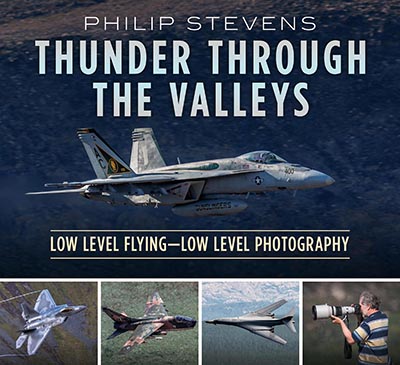 Two books in one, my book covers military low flying and the challenges faced by the photographer. The main subject is about military low-flying - the skills, reasons and dangers from a pilot's perspective. The many commanders, pilots and mission planners interviewed explain the challenges they face flying fast and low day and night. Pilots describe their training, planning, systems and their most memorable missions flying the aircraft they love from the; A-7 Corsair, F-4 Phantom, Tucano, Tornado, Sk 60, B-1B Lancer, F-16 Fighting Falcon, F-16I Sufa, F/A-18 Super Hornet to even the F-22 Raptor. The photographer reveals how and where images were taken from mountainsides and desert canyons to cockpits for air to air images.
Two books in one, my book covers military low flying and the challenges faced by the photographer. The main subject is about military low-flying - the skills, reasons and dangers from a pilot's perspective. The many commanders, pilots and mission planners interviewed explain the challenges they face flying fast and low day and night. Pilots describe their training, planning, systems and their most memorable missions flying the aircraft they love from the; A-7 Corsair, F-4 Phantom, Tucano, Tornado, Sk 60, B-1B Lancer, F-16 Fighting Falcon, F-16I Sufa, F/A-18 Super Hornet to even the F-22 Raptor. The photographer reveals how and where images were taken from mountainsides and desert canyons to cockpits for air to air images.Pilots fly low to deliver weapons or gather data and evade Radar. Pilots from air forces across Europe and the United States talk about the skills they need to be effective in very dangerous flying environments. They discuss the challenging flying conditions they face when flying fast and low over snow, the sea or through mountain ranges at night. Commanders with many years of low-level flying experience give a fascinating insight in to their most memorable sorties and experiences from days gone by. Thunder Through the Valleys: Low Level Flying - Low Level Photography Published by Fonthill Media. ISBN: 978-1-78155-724-2 Size: 225 x 248 mm Extent: 128 pages Illustrations: 187 colour Price: £25 / $40 in paperback. |
 |
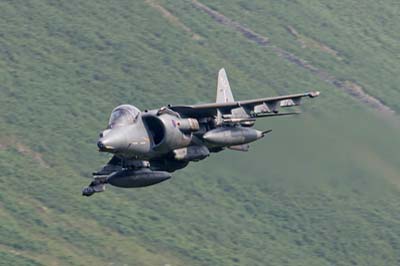 |
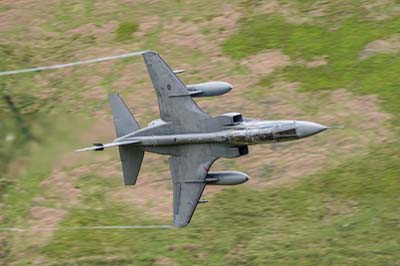 |
| Left to right: This 208(R) Squadron Hawk was captured in the early morning light (09:10) in April 2007 it stands out nicely against the misty background. DSLR x1.6 sensor + Canon EF 300mm f2.8L f.7.1 1/500 at ISO 200. This image from August 2004 of Harrier GR.7 (ZG857) from the former Fast Jet & Weapons OEU was the first in a sequence and has been cropped quite a bit. The angle of the aircraft is very attractive and the gentle light from behind enhances the aircraft's contours. This image was selected for the RAF Calendar. Jaguar T.4 of 6 Squadron just before their disbandment in May 2007. The weather was overcast and so I was able to capture this shot from a south facing hill in Wales during the mid-afternoon. The damp weather has caused attractive vortices to be formed from the wing tips. DSLR x1.6 sensor + Canon EF 300mm f2.8 L f.4 1/640 ISO 200. |
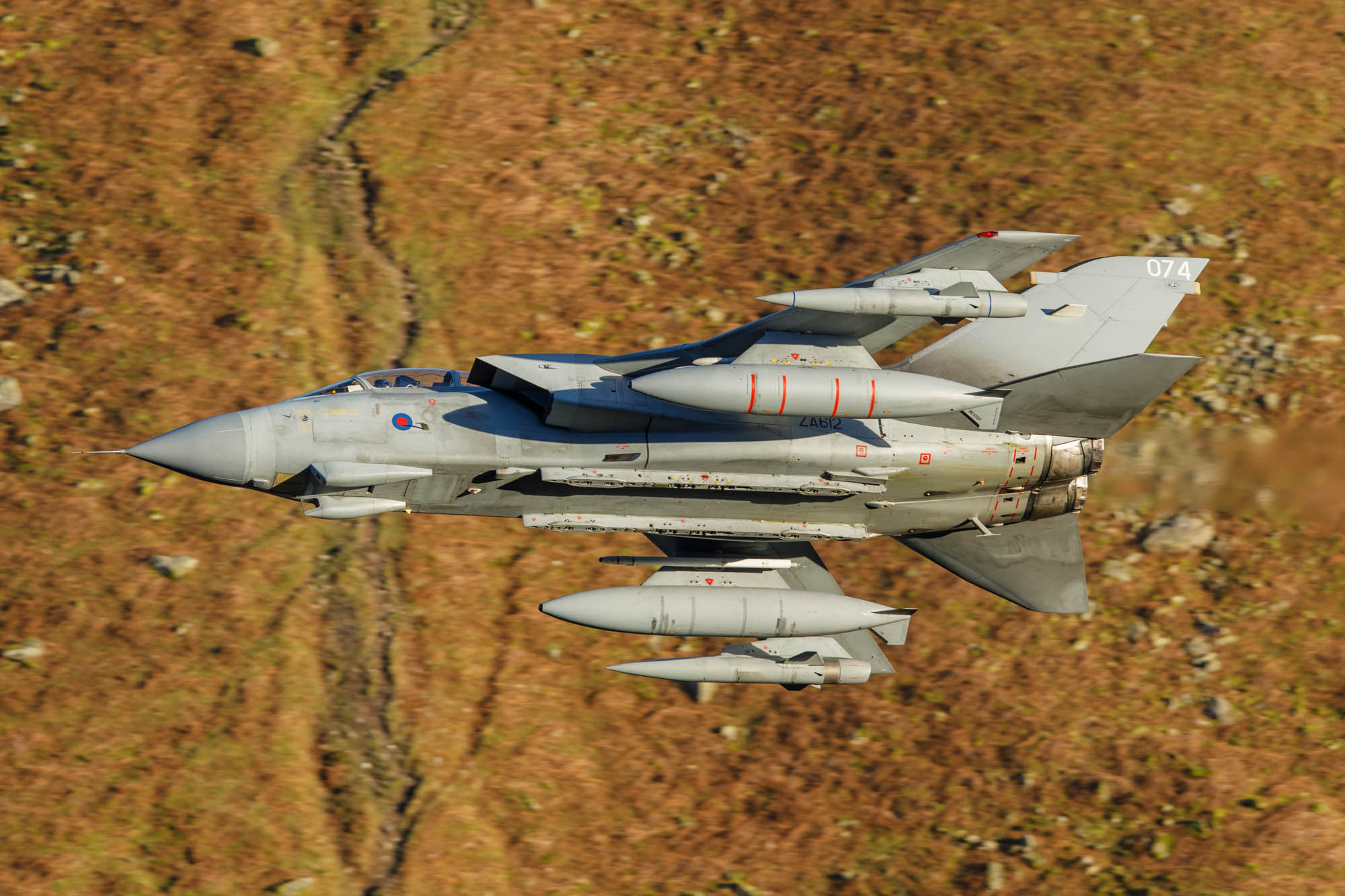 |
| Tornado GR.4 (ZA612 '074') with IX(B) Squadron and using callsign 'Marham 42' flying low through the Lake District after it had passed low in Wales, late on January 9, 2019, perhaps the last GR.4 to fly low in the UKLFS, following the TGRF Commander's decision the next day to end Tornado GR.4 low flying prior to its retirement in March. |
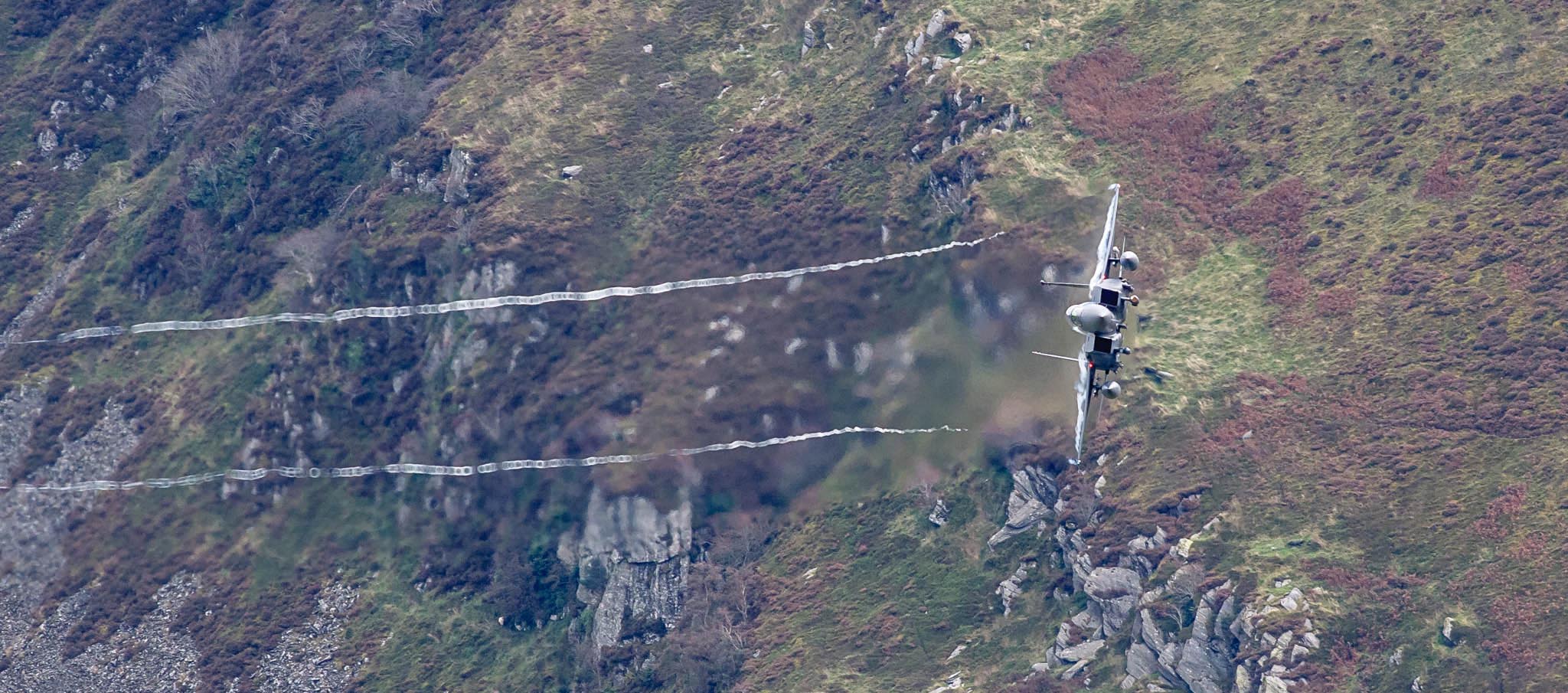 |
| Damp days will produce these vortices or 'streamers' trailing from an F-15E Strike Eagle's wing tips and upper surfaces From the top of the valley this was one of a sequence of images taken with a DSLR x1.6 sensor + Canon EF 300mm f2.8L lens in October 2009. |
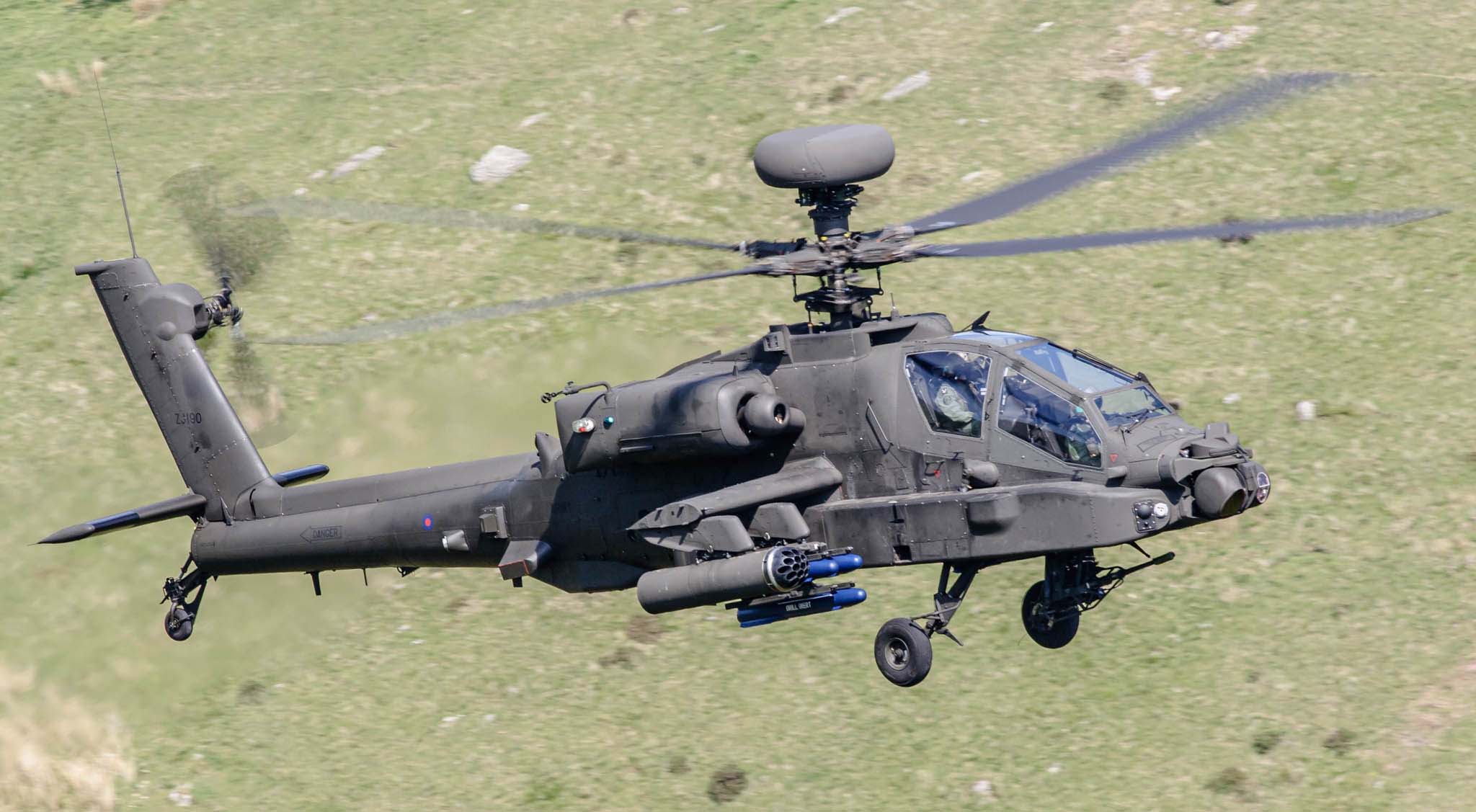 |
| Apache AH.1 (ZJ190) of Army Air Corps 662 Squadron, 3 Regiment in June 2006. Reducing the camera's shutter speed for propellers and rotors is used to increase blur and show movement, but this increases the risk of a soft or blurred image. DSLR x1.6 sensor + Canon EF 300mm f2.8L f.11 1/125. |
|
The best shots from the best spots: Most of the images in this report were taken in the hills of Wales (LFA 7), Cumbria (LFA 17) and the Scottish Borders (LFA 20T). |
| Photogenic angles are what I constantly look for, with the right combination of the location, weather and time of day will produce the best images. |
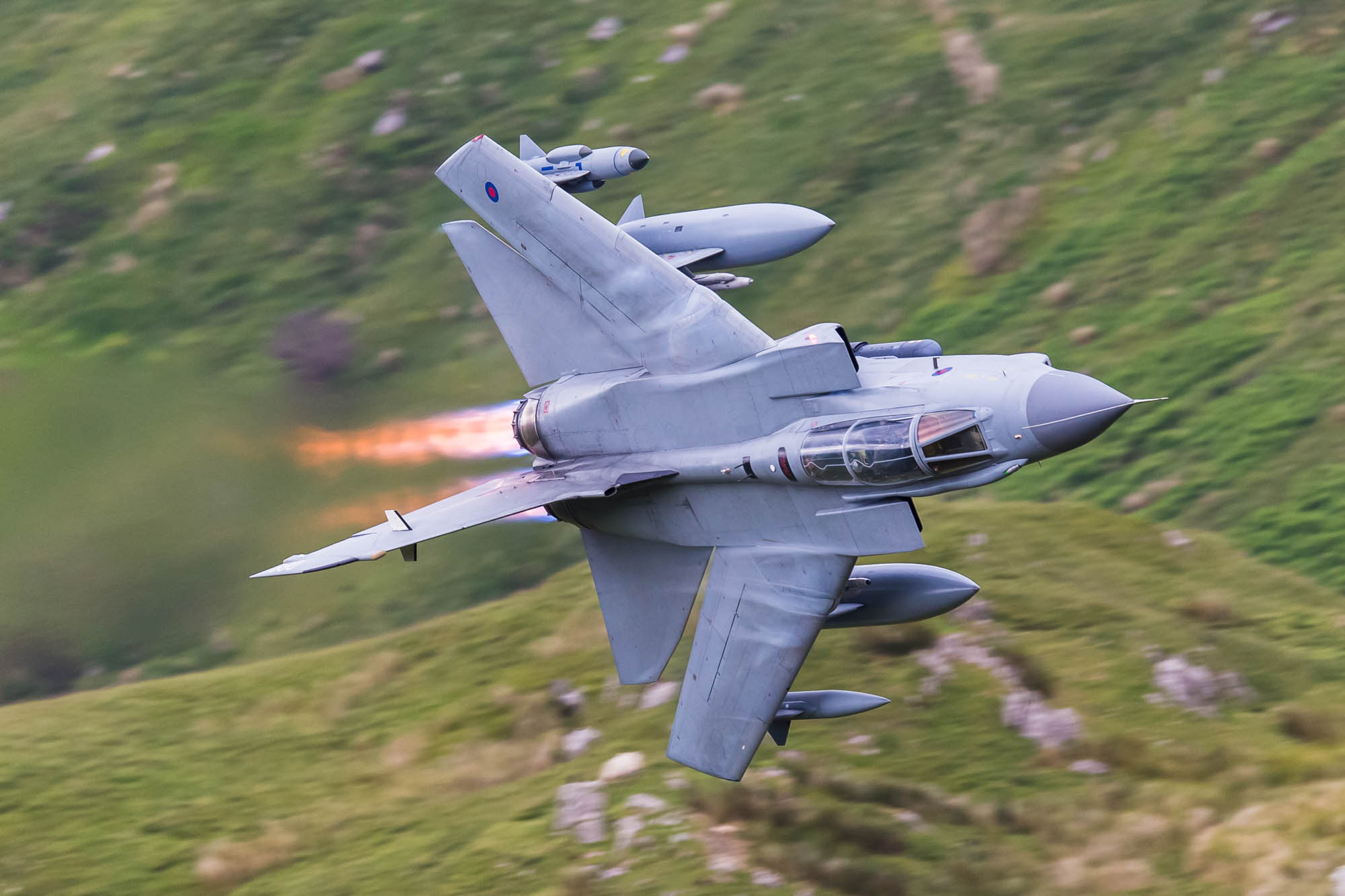 |
| Tornado GR.4 (ZA606 '069') at 550 mph in 'combat mode'. |
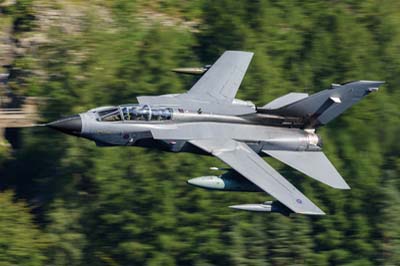 |
 |
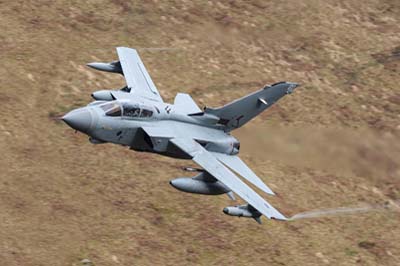 |
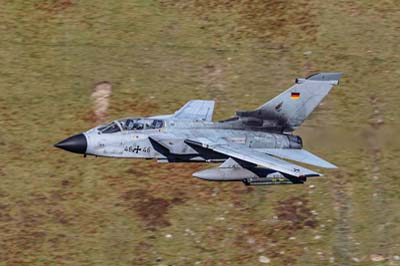 |
| Left to right: Tornado GR.4A (ZA402) is used as a systems test aircraft operated by BAE Systems out of Warton and seen in September 2006. Tornado GR.4 (ZA473/-) of 12(B) Squadron in October 2008. DSLR x1.6 sensor + Canon EF 300mm f2.8L at 1/640 at f.6.3 with -2/3 exposure compensation and ISO 200. Tornado GR.4 (ZD792) in March 2012. DSLR x1.6 sensor + Canon EF 400mm f2.8L at 1/800 f4.5 ISO 200 with -2/3 exposure compensation. Tornado ECR (46+49) of German Air Force JBG 32 in the Selkirk to Moffat valley in October 2012. DSLR full-frame sensor + Canon EF 400mm f2.8 L IS Mk.II plus a x1.4 extender at 1/1000 f5.6 ISO 100 with -2/3 exposure compensation. |
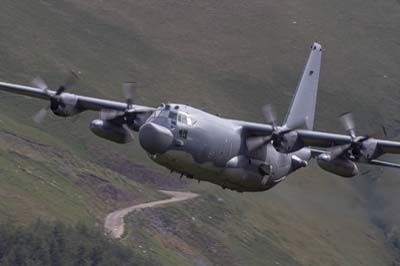 |
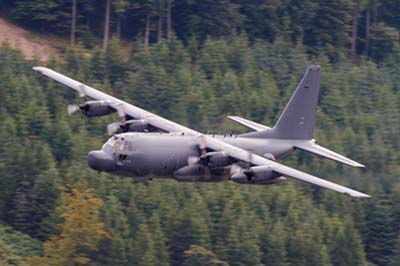 |
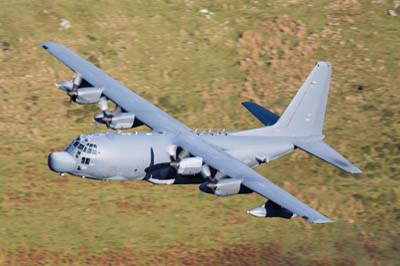 |
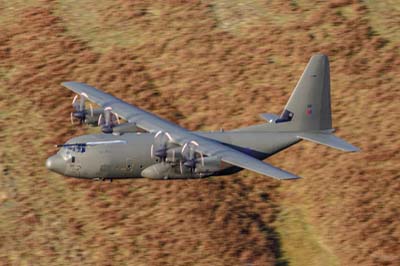 |
| Left to right: MC-130H Combat Talon II (87-0024) of 7th SOS, 352 SOG using callsign 'Talon 71' in May 2011. DSLR x1.6 sensor + Canon EF 300mm f2.8L at 1/320 at f.7.1 with -1 exposure compensation and ISO 100. US Special Forces MC-130H Combat Talon II (88-0195) in August 2010. DSLR x1.6 sensor + Canon EF 300mm f2.8L at 1/250 f.5 ISO 100 with -2/3 stop exposure compensation. MC-130H Combat Talon II (88-1803) in December 2014 on its last operational filight in the UK. DSLR full-frame sensor + Canon EF 400mm f2.8 L IS Mk.II at 1/250 f7.1 ISO 100 with -1/3 exposure compensation. C-130J Hercules C.5 (ZH881) of 30 Squadron through the TTA in the Selkirk to Moffat valley in October 2012. DSLR full-frame sensor + Canon EF 400mm f2.8 L IS Mk.II at 1/200 f10 ISO 200 with -2/3 exposure compensation. |
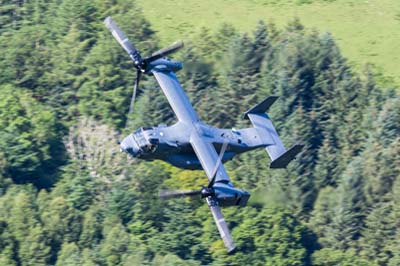 |
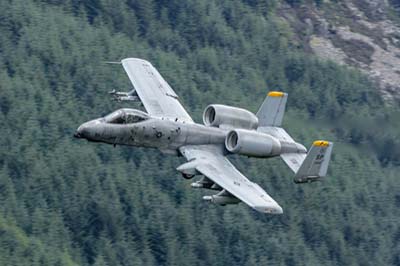 |
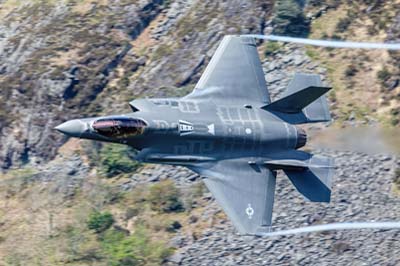 |
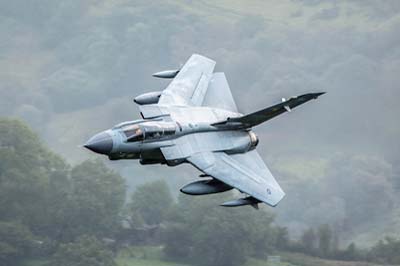 |
| Left to right: Bell CV-22B Osprey (11-0058) using callsign 'Knife 75' from the 7th Special Operations Squadron based at RAF Mildenhall in July 2015. DSLR full-frame sensor + Canon EF 400mm f2.8 L IS Mk.II at 1/320 f9 ISO 100 with -2/3 exposure compensation. A-10A Thunderbolt II (82-0650 'SP') of 81st FS, 52nd FW deployed to RAF Lakenheath in July 2007, while the runway at their home base of Spangdahlem in Germany was being resurfaced. F-35A Lightning II (12-5097 'HL') of 34 FS using callsign 'Rude 62' during a deployment from RAF Lakenheath in May 2017. Tornado GR.4 (ZA560 'EB-Q') using callsign 'Viking 41' of 41(TES) Test & Evaluation Squadron, swept with burners, September 2017. |
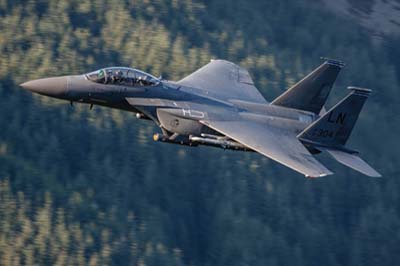 |
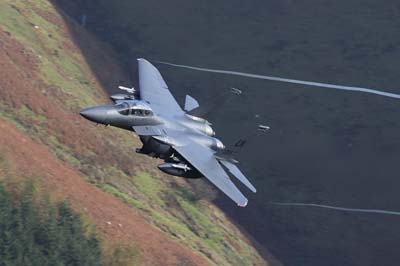 |
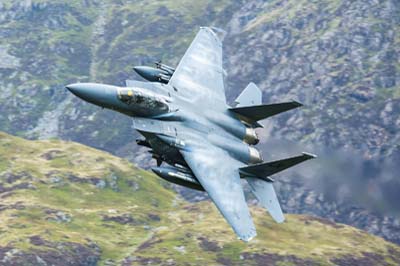 |
| Left to right: F-15E Strike Eagle (91-0304 'LN') callsign 'Dirty 51' of 492FS, 48FW it was first of a pair making their passes at 18:14 in September 2009, this aircraft was later to crash in Libya on March 22, 2011 during operation Odyssey Dawn to secure a no fly zone, both crew ejected safely. DSLR x1.6 sensor + Canon EF 300mm f2.8L at 1/800 at f.4.5 with -2/3 exposure compensation and ISO 200. F-15E Strike Eagle (96-0205 'LN') of the 492FS, 48FW based at RAF Lakenheath in early morning in October 2008. F-15E Strike Eagle (98-135 'LN') 492FS callsign 'Eagle 12' in May 2015. DSLR full-frame sensor + Canon EF 400mm f2.8 L IS Mk.II at 1/1250 f5.6 ISO 320 with -1/3 exposure compensation. |
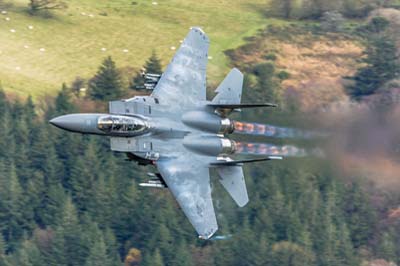 |
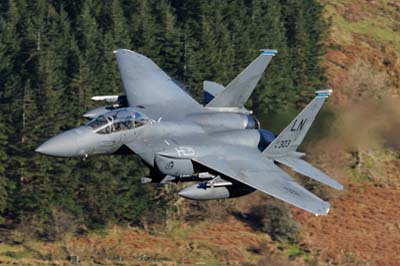 |
| Left to right: F-15E Strike Eagle (91-312 'LN') callsign 'Rage 11' in colours (blue fin tip) of 492 FS, 48 FW in November 2017. DSLR full-frame sensor + Canon EF 400mm f2.8 L IS Mk.II at 1/1000 f2.8 ISO 320 with -1/3 exposure compensation. F-15E Strike Eagle (91-0303 'LN') callsign 'Steak Flight' with 492FS, 48FW in January 2022. DSLR full-frame sensor + Canon EF 400mm f2.8 L IS Mk.II + x1.4 Extender Mk.III at 1/1600 f6.3 ISO 400 with -1/3 exposure compensation. |
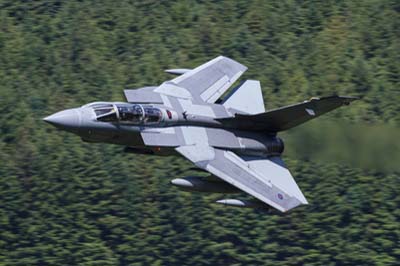 |
 |
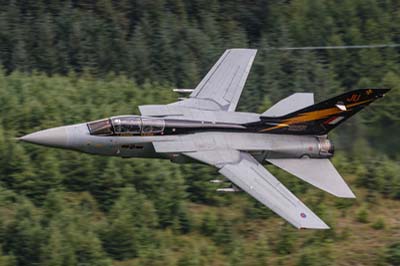 |
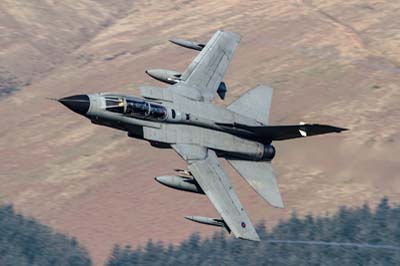 |
| Left to right: Tornado GR.4 (ZA452 '021') of 31 Squadron with 67 degree swept wings and afterburners (or reheat) in June 2010. DSLR x1.6 sensor + Canon EF 300mm f2.8L at 1/800 f.8 ISO 200 with -1.1/3 stop exposure compensation. DSLR full-frame sensor + Canon EF 400mm f2.8 L IS Mk.II plus a x1.4 extender at 1/1000 f5.6 ISO 200 with -1/3 exposure compensation. Tornado GR.4 (ZG713 '123-G') in 2 Squadron colours its second pass included a 67 degree wing sweep in December 2012. Tornado F.3 (ZE734 'JU') in 111 Squadron special colours in July 2009. Tornado GR.4 (ZA404 '013') in 14 Squadron colours and using callsign 'Valkyrie 2' in March 2011. DSLR x1.6 sensor + Canon EF 300mm f2.8L at 1/800 f.9 ISO 200 with -1 stop exposure compensation. |
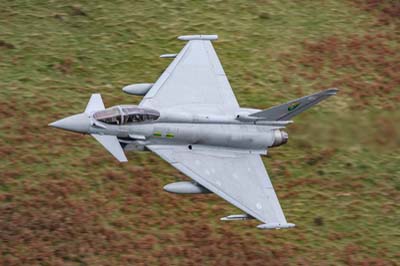 |
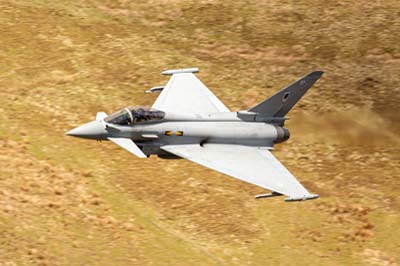 |
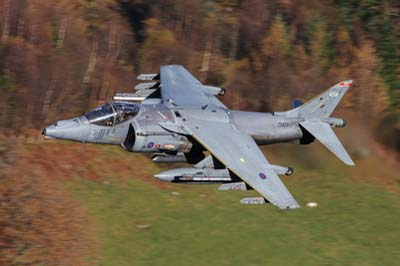 |
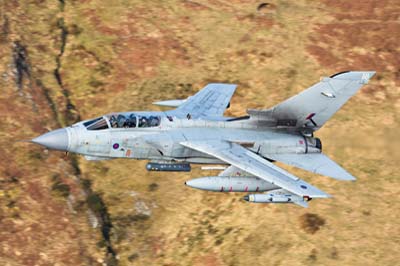 |
| Left to right: First of a pair of Typhoon FGR.4s (ZJ918 'QO-L') callsign 'Rampage' of 3(F) Squadron in Wales in October 2009. DSLR x1.6 sensor + Canon EF 300mm f2.8L at 1/800 f.3.5 ISO 200 with -2/3 stop exposure compensation. Typhoon FGR.4 (ZJ915 'BY') in new 11 Squadron markings but retaining its original 29(R) Squadron 'BY' tail code in mid Wales in April 2013. DSLR full-frame sensor + Canon EF 400mm f2.8 L IS Mk.II at 1/1000 f8 ISO 200 with -2/3 exposure compensation. Harrier GR.9A (ZD433 '45A') of 1(F) Squadron with an impressive array of mission markings from its deployment to Afghanistan in November 2010. DSLR x1.6 sensor + Canon EF 300mm f2.8L at 1/800 f.7.1 ISO 200 with -1 exposure compensation. Tornado GR.4A (ZG705 '118') using callsign 'Marham 57' with faded mission marks. DSLR full-frame sensor + Canon EF 400mm f2.8 L IS Mk.II at 1/1250 f6.3 ISO 250 with -2/3 exposure compensation. |
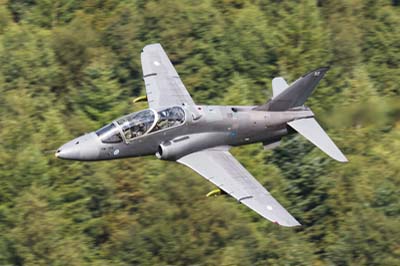 |
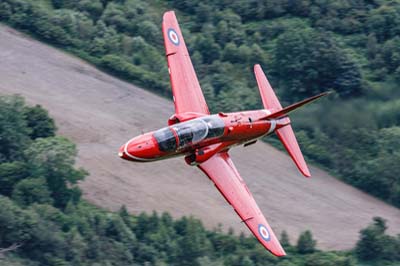 |
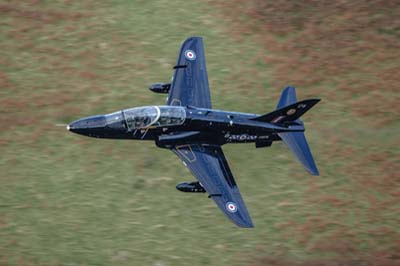 |
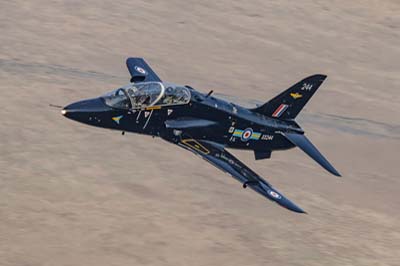 |
| Left to right: Finnish Air Force (Ilmavoimat) Hawk T.51A (HW-355) from the Central Flying School (Ilmasotakoulu) based at Kauha during their deployment to RAF Valley in September 2013. DSLR full-frame sensor + Canon EF 400mm f2.8 L IS Mk.II plus a x1.4 extender at 1/1000 f5.6 ISO 200 with -2/3 exposure compensation. First of a pair of Typhoon FGR.4s (ZJ918 'QO-L') callsign 'Rampage' of 3(F) Squadron in Wales in October 2009. DSLR x1.6 sensor + Canon EF 300mm f2.8L at 1/800 f.3.5 ISO 200 with -2/3 stop exposure compensation. Red Arrow Hawk T.1A (XX253) callsign 'Red 11' on its way from RIAT at Fairford to RAF Valley before continuing on to its home base at RAF Scampton in July 2009. DSLR x1.6 sensor + Canon EF 300mm f2.8L at 1/800 at f.5 with -2/3 exposure compensation and ISO 200. Hawk T.1W (XX178) of 19(R) Squadron fitted with CBLS (Carrier, Bomb, Light, Store) pods under each wing. The CBLS are sometimes fitted for training sorties to show the student the differences of the handling and higher fuel consumption with stores fitted. DSLR x1.6 sensor + Canon EF 300mm f2.8L at 1/640 f.2.8 ISO 200 with -2/3 stop exposure compensation. Hawk T.1 (XX244) in 208(R) Squadron colours in March 2011. DSLR x1.6 sensor + Canon EF 300mm f2.8L at 1/800 f.10 ISO 200 with -1 stop exposure compensation. |
| Top shots of aircraft with the opposing hillside in the background are perhaps the most exciting of all low-level images they demonstrate low-flying perfectly. In low humidity vortices from the wing's upper surfaces and a blurred background further emphasise action. |
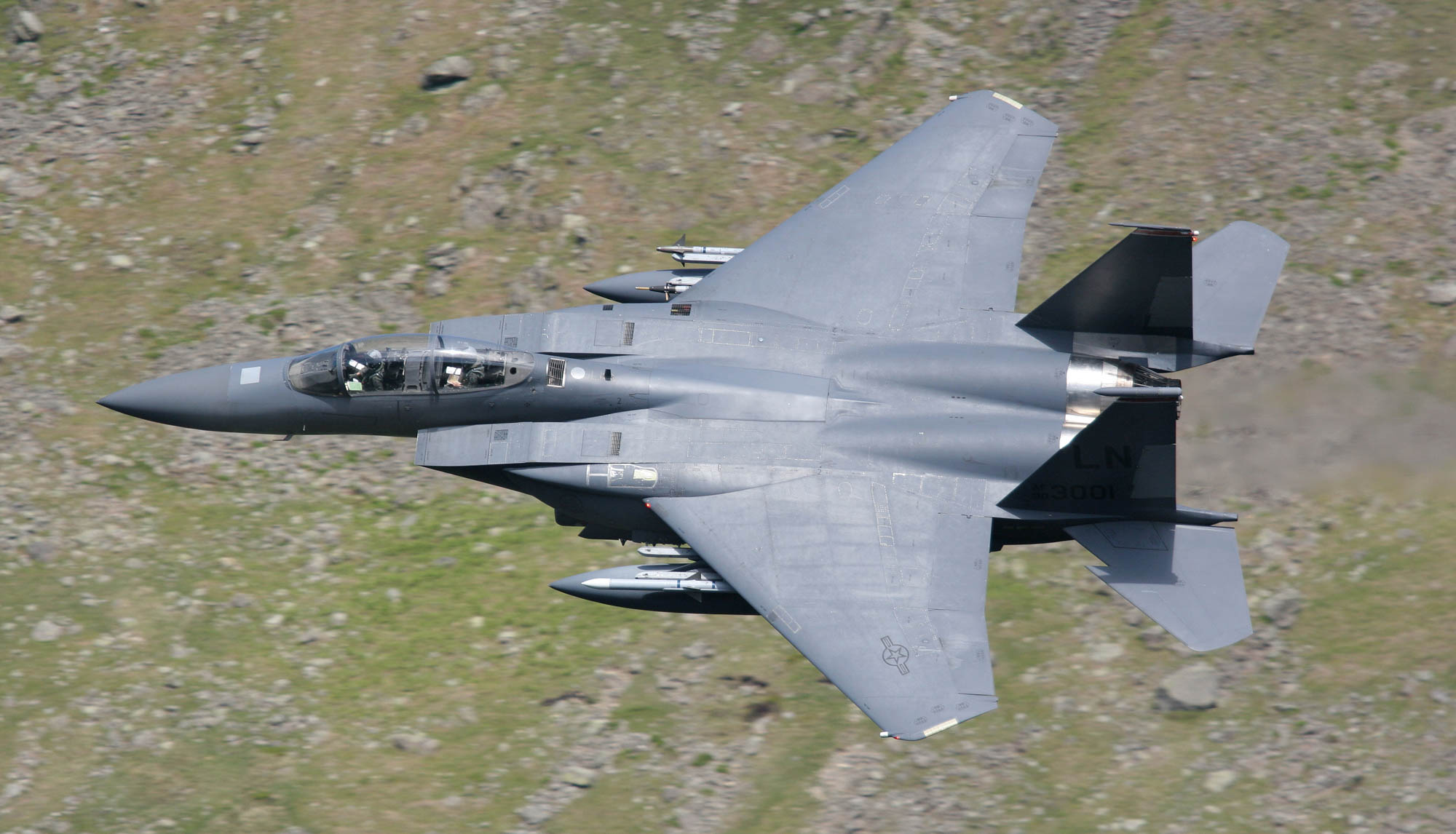 |
| RAF Lakenheath based F-15E Strike Eagle it was first of a pair in June 2005 |
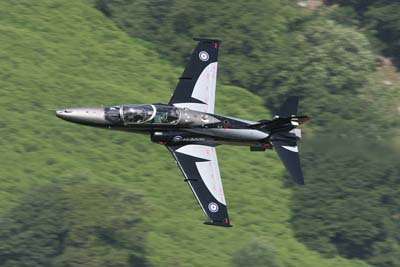 |
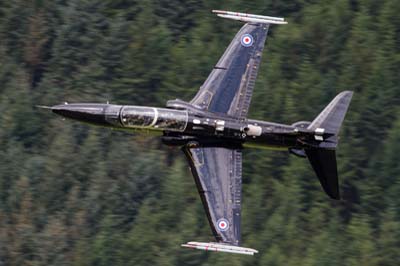 |
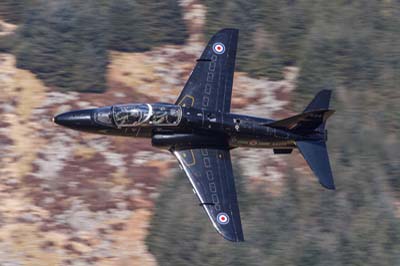 |
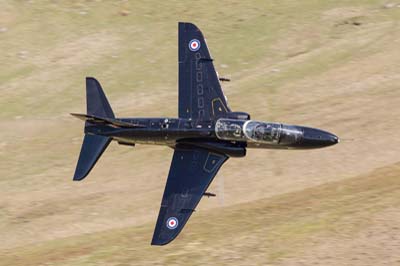 |
| Left to right: BAE Systems Hawk 100 demonstrator (ZJ951) in its new paint scheme applied specially for the SBAC show at Farnborough to which it was flying in July 2006. Hawk T.2 (ZK025) with 19(R) Squadron in August 2011. DSLR x1.6 sensor + Canon EF 300mm f2.8L at 1/800 at f.5 with -1 stop exposure compensation and ISO 200. Hawk T.1 (XX234) of 208(R) Squadron in March 2010. DSLR x1.6 sensor + Canon EF 300mm f2.8L at 1/640 at f.7.1 with -1 stop exposure compensation and ISO 200. Hawk T.1 (XX199) of 208(R) Squadron in June 2013. DSLR full-frame sensor + Canon EF 400mm f2.8 L IS Mk.II at 1/1000 f7.1 ISO 200 with -2/3 exposure compensation. |
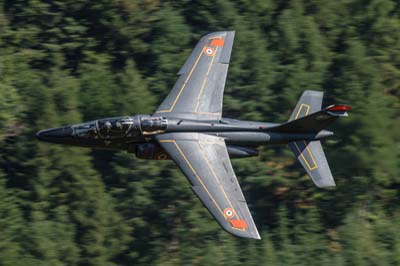 |
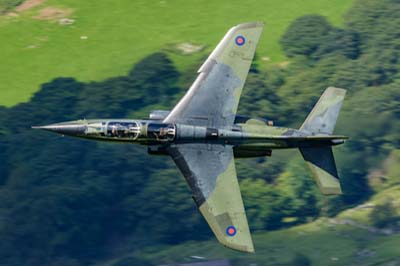 |
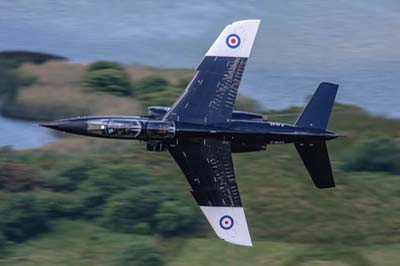 |
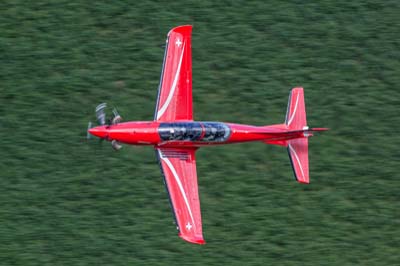 |
| Left to right: French Air Force Alpha Jet E (E104 '705-TG') in June 2010. Alpha Jet (ZJ645 '45') in a new black and white QinetiQ scheme in June 2009. DSLR x1.6 sensor + Canon EF 300mm f2.8L plus x1.4 extender at 1/640 at f.4.5 with -2/3 exposure compensation and ISO 200. Alpha Jet (ZJ646) with DPA/AFD/QinetiQ at Boscombe Down in July 2007. Swiss Air Force Pilatus PC-21 (A-106) in August 2015. DSLR full-frame sensor + Canon EF 400mm f2.8 L IS Mk.II at 1/320 f7.1 ISO 200 with -1 stop exposure compensation. |
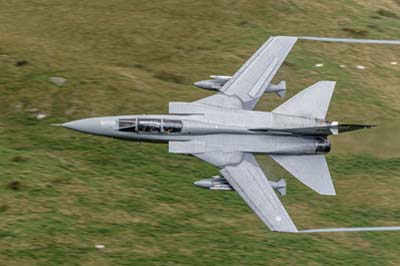 |
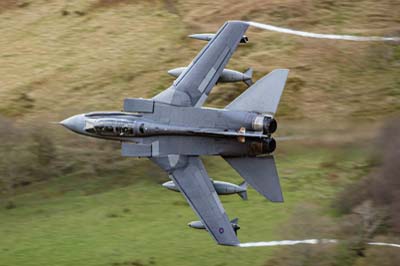 |
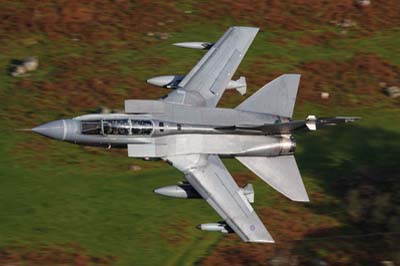 |
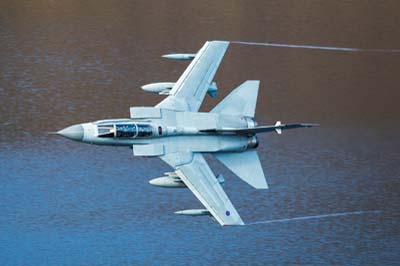 |
| Left to right: Tornado F.3 of 111 Squadron (ZE158 'HG') from RAF Leuchars in August 2005. Tornado GR.4 (ZG775 '134') in 12(B) Squadron colours but using callsign 'Marham 31' when on a low-level sortie through Wales in November 2007. Remarkably if you look very closely the third panel from front on right is lifting during the high-G turn. RAF Marham phoned back following my warning call and inspection to say they were "extremely grateful" for alerting them of the potentially serious problem. Tornado GR.4 (ZD810 '102') it has 'Spirit of Speyside' nose art and was in XV Squadron markings in October 2008. DSLR x1.6 sensor + Canon EF 300mm f2.8L at 1/640 at f.7.1 with -2/3 exposure compensation and ISO 200. Tornado GR.4 (ZA462 '027') 100 feet AGL when flying low through a TTA in LFA20(T) in February 2016. (DSLR full-frame sensor + Canon EF 400mm f2.8L IS Mk.II at 1/1000 f.3.5 ISO 200 with -1/3 exposure compensation). |
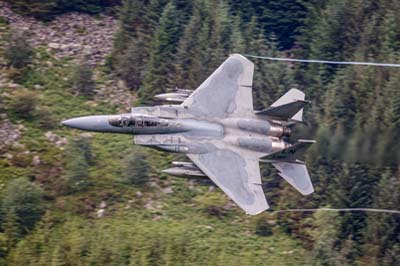 |
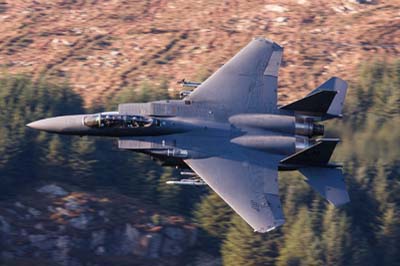 |
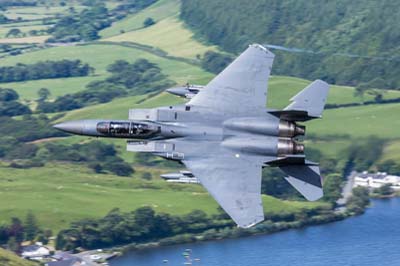 |
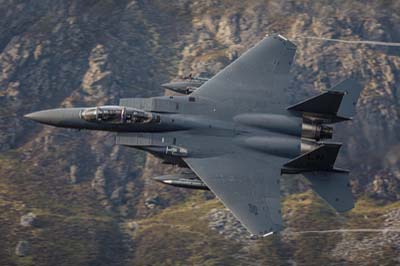 |
| Left to right: F-15D Eagle (86-0182 'LN') of 493 FS, 48 FW in July 2012. DSLR full-frame sensor + Canon EF 400mm f2.8 L IS Mk.II at 1/1000 at f3.5 with -1/3 exposure compensation and ISO 250. F-15E Strike Eagle (98-0133 'LN') callsign 'Dirty 52' of 492 FS, 48 FW in September 2009 at 18:17. DSLR x1.6 sensor + Canon EF 300mm f2.8L at 1/800 at f.3.5 with -2/3 exposure compensation and ISO 200. F-15E Strike Eagle (91-0332 'LN') with blue fin tips it is inscribed '492 FS' in July 2014. DSLR full-frame sensor + Canon EF 400mm f2.8 L IS Mk.II at 1/1000 at f.7.1 with -1/3 exposure compensation and ISO 200. F-15E Strike Eagle (91-315 'LN') using callsign 'Raider 53' in the colours of 492nd FS, 48 FW in October 2019. DSLR full-frame sensor + Canon EF 400mm f2.8 L IS Mk.II at 1/1600 at f.4 with -1 exposure compensation and ISO 200. |
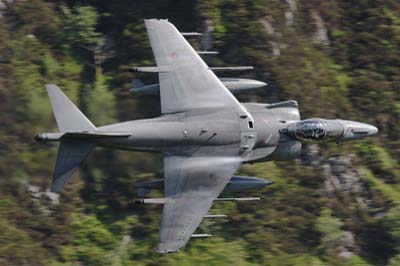 |
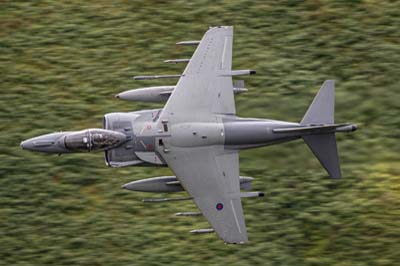 |
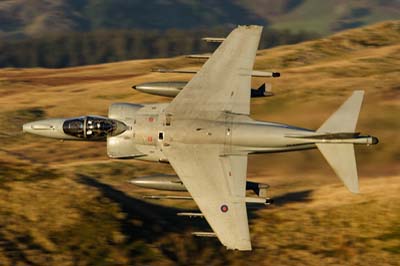 |
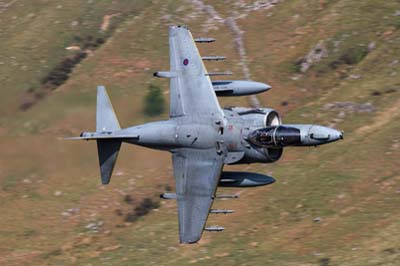 |
| Left to right: Unmarked Harrier GR.9 (ZD375 '23') in June 2009. DSLR x1.6 sensor + Canon EF 300mm f2.8L at 1/800 at f.5.6 with -2/3 exposure compensation and ISO 200. Harrier GR.9A (ZD349 '15') with the Naval Strike Wing in July 2009. DSLR x1.6 sensor + Canon EF 300mm f2.8L at 1/640 at f.3.2 with -2/3 exposure compensation and ISO 200. Harrier GR.9 (ZD406 '35') in joint 800/801 Naval Air Squadron markings just before sunset at the end of November 2007. In March 2007 the Naval Strike Wing (NSW) was formed comprising elements of 800 and 801 Squadrons. Harrier GR.9 (ZD438 '50') still in its old 4(AC) Squadron markings in May 2010. DSLR x1.6 sensor + Canon EF 300mm f2.8L at 1/1000 at f.9 with -1 stop exposure compensation and ISO 200. |
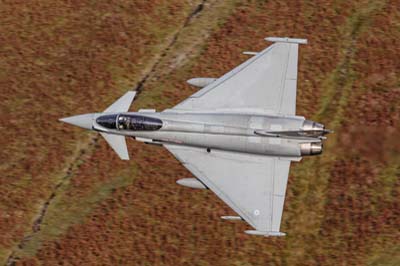 |
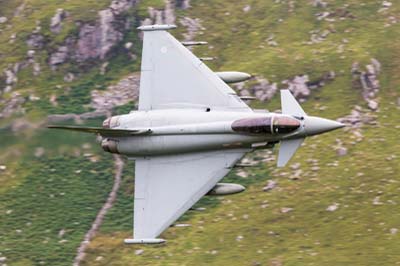 |
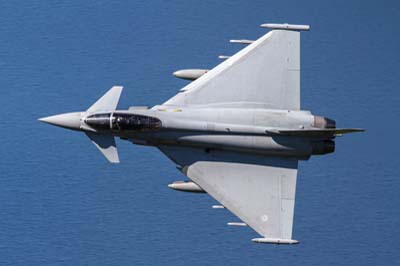 |
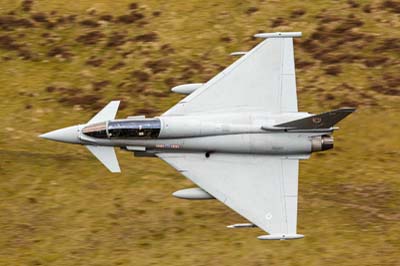 |
| Left to right: Typhoon FGR.4 (ZK307 'BU') of 29(R) Squadron in the Selkirk to Moffat valley in October 2012. DSLR full-frame sensor + Canon EF 400mm f2.8 L IS Mk.II plus a x1.4 extender at 1/1250 f7.1 ISO 200 with -2/3 exposure compensation. Typhoon FGR.4 (ZJ927 'BO') of 29(R) Squadron in July 2014. DSLR full-frame sensor + Canon EF 400mm f2.8 L IS Mk.II at 1/1000 f5 ISO 200 with -1/3 exposure compensation. Typhoon FGR.4 (ZJ942 'DH') in 11 Squadron markings as it passed over Tal-y-llyn lake in mid-Wales in July 2011. Typhoon T.3 (ZK380 'BG') of 29(R) Squadron in mid Wales in April 2013. DSLR full-frame sensor + Canon EF 400mm f2.8 L IS Mk.II at 1/800 f5.6 ISO 200 with -1/3 exposure compensation. |
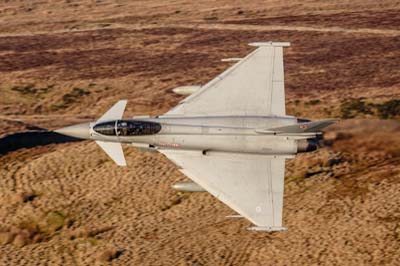 |
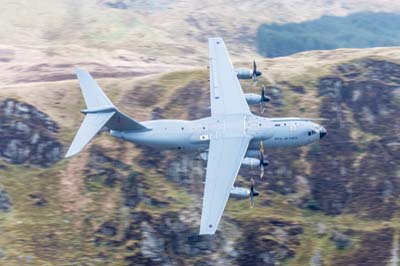 |
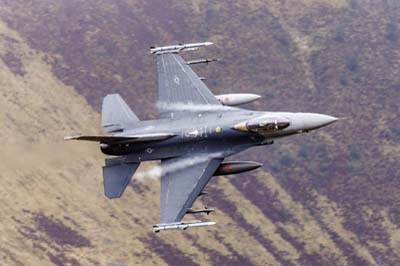 |
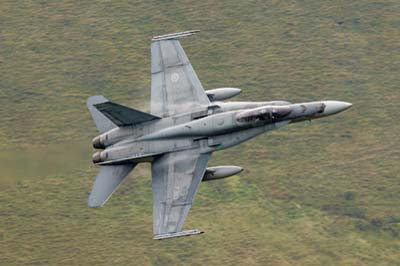 |
| Left to right: Typhoon FGR.4 (ZK331 'BT') of 29(R) Squadron in January 2017. DSLR full-frame sensor + Canon EF 400mm f2.8 L IS Mk.II at 1/1250 f7.1 ISO 250 with -2/3 exposure compensation. A400M Atlas C.1 (ZM417) using callsign 'Comet 456' it is with 70 (LXX) Squadron in April 2018. DSLR full-frame sensor + Canon EF 70mm-200mm (102mm) f2.8 L IS Mk.II at 1/160 f5.6 ISO 200 with -1/3 exposure compensation. F-16CM-40E Fighting Falcon (89-2011 'AV') using callsign 'SCOFF 11' with 510 FS, 31 FW based at Aviano and deployed to RAF Lakenheath in March 2022. Mirrorless DSLR full-frame sensor + Canon EF 400mm f2.8 L IS at 1/2000 f2.8 ISO 500 with -1/3 exposure compensation. McDonnell Douglas CF-188 Hornet (188730) callsign 'Blade 2' with 433 Tactical Fighter Squadron, Royal Canadian Air Force (RCAF) from CFB Bagotville in Quebec, deployed to RAF Waddington for Exercise Cobra Warrior 23-2 in September 2023. Mirrorless DSLR full-frame sensor + Canon EF 400mm f2.8 L IS at 1/2000 f4 ISO 250 with -2/3 exposure compensation. |
| Going knife edge |
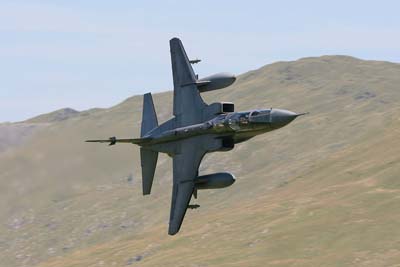 |
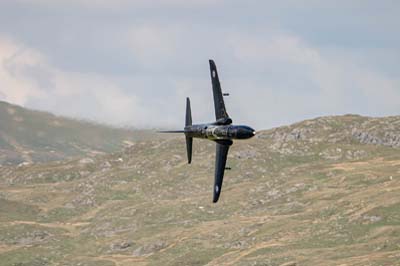 |
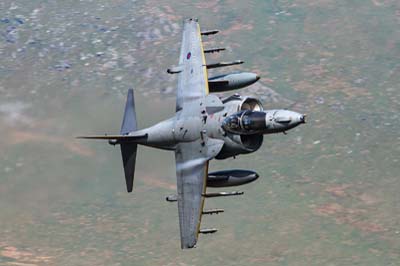 |
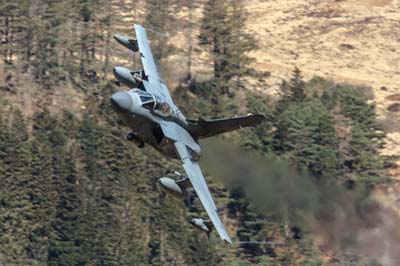 |
| Left to right: Two-seat Jaguar T.4 (XX841) when operating with QinetiQ at Boscombe Down in 2006. Hawk T.1 of 4 FTS from RAF Valley in 2004. Harrier GR.9 (ZG859 '91') in 1(F) Squadron markings, at 17:20 in May 2010. DSLR x1.6 sensor + Canon EF 300mm f2.8L at 1/1000 at f.9 with -1 stop exposure compensation and ISO 200. Tornado GR.4A (ZA401 '012') with 2 Squadron and fitted with a (AN/AAQ-28) Litening targeting pod in March 2010. DSLR x1.6 sensor + Canon EF 300mm f2.8L and x1.4 extender at 1/800 at f8 with -1 stop exposure compensation and ISO 200. |
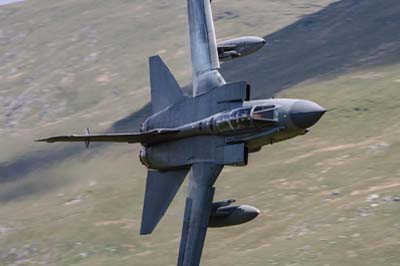 |
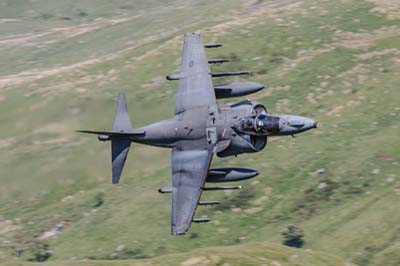 |
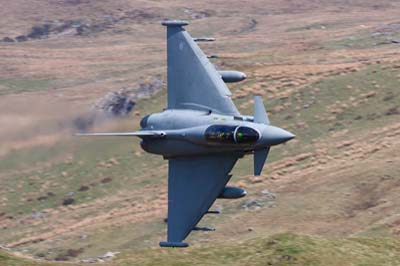 |
 |
| Left to right: Tornado GR.4 (ZA370 '004') in June 2009. Harrier GR.9 (ZD468 '58') in June 2009. Typhoon T.1 (ZJ814 'QO-Z') of 3(F) Squadron in May 2008 C-130J-30 Hercules C.4 (ZH875) of 30 Squadron in March 2012. DSLR x1.6 sensor + Canon EF 400mm f2.8L at 1/250 at f4.5 with -2/3 stop exposure compensation and ISO 100. |
| Bottom shots from the outside of a turn, showing weapons in the case of frontline fighters are well worth going for. |
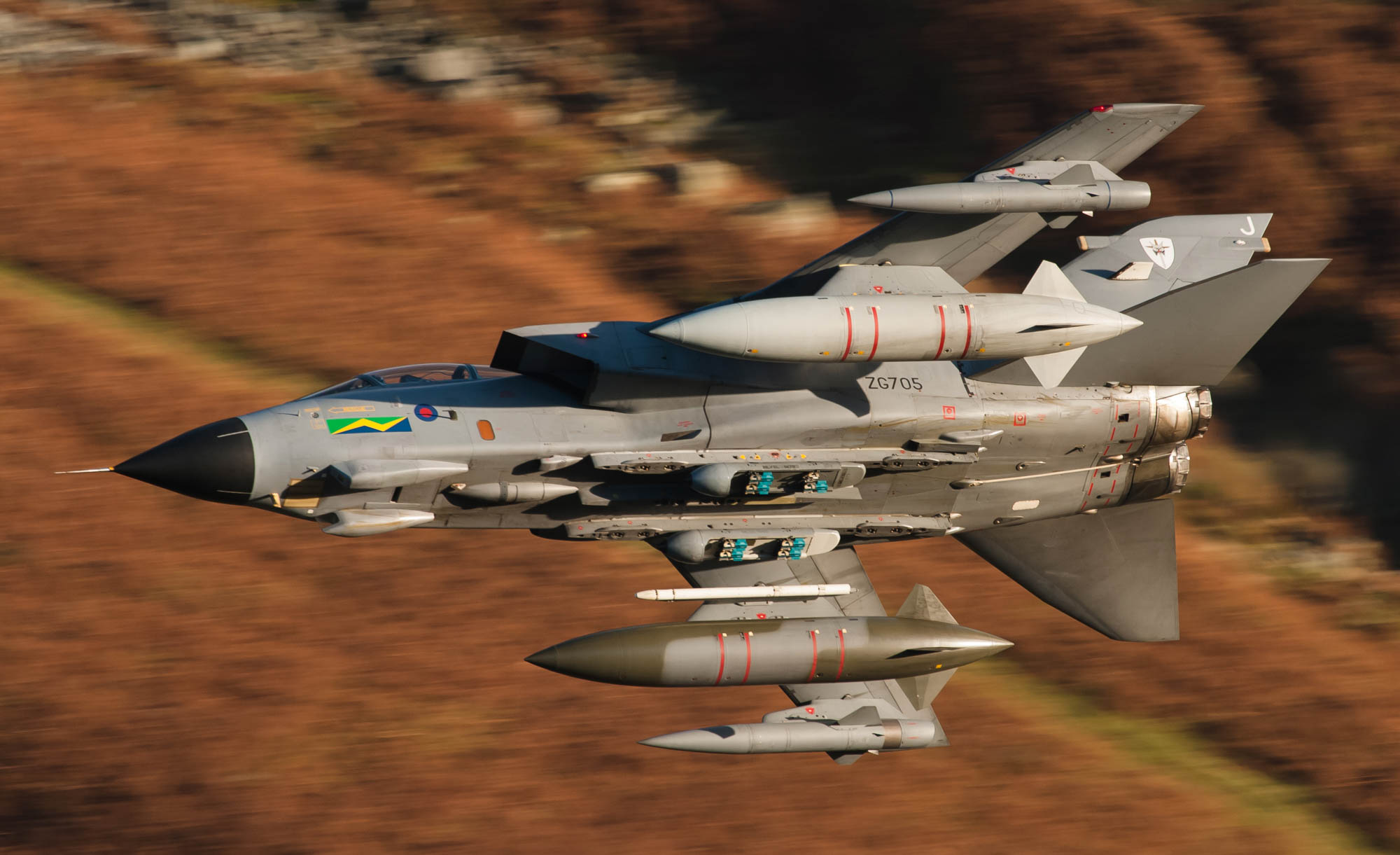 |
| Tornado GR.4A (ZG705 'J') of 13 Squadron RAF Marham, carrying inert practice bomblets in two CBLS (Carrier, Bomb, Light Stores) pods. DSLR x1.6 sensor + Canon EF 100-400mm L IS (at 400mm) f.5.6 -1/2 exposure compensation 1/350 ISO 200. |
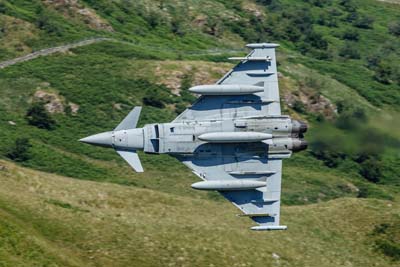 |
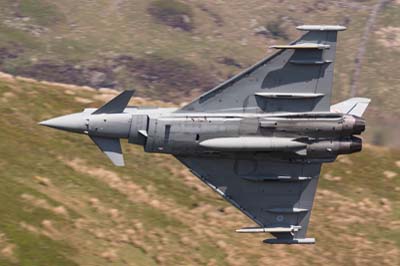 |
 |
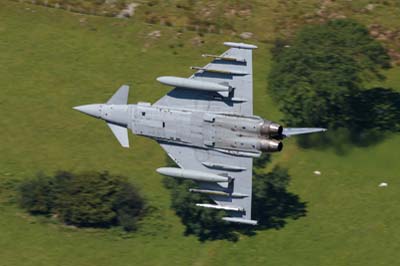 |
| Left to right: Typhoon T.3 (ZJ802 '802'). DSLR full-frame sensor + Canon EF 400mm f2.8 L IS Mk.II at 1/1250 f6.3 ISO 200 with -1 exposure compensation. Typhoon T.3 (ZK307 'BU') of 29(R) Squadron in June 2013. DSLR full-frame sensor + Canon EF 400mm f2.8 L IS Mk.II at 1/1000 f.9 ISO 200 with -2/3 exposure compensation. Typhoon T.3 (ZJ814 'BH') of 29(R) Squadron in September 2013. DSLR full-frame sensor + Canon EF 400mm f2.8 L IS Mk.II plus x1.4 extender at 1/1000 f9 ISO 200 with -2/3 exposure compensation. Typhoon FGR.4 (ZJ942 'DH') in July 2011. DSLR x1.6 sensor + Canon EF 300mm f2.8L 1/1000 at f7.1 ISO 200 -1 stop exposure compensation. |
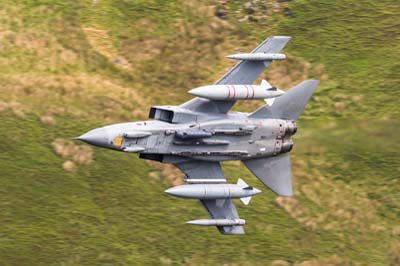 |
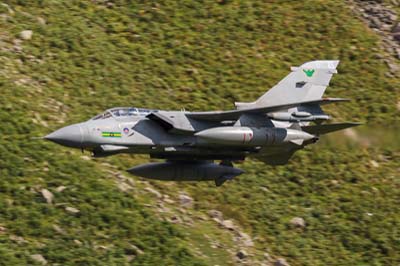 |
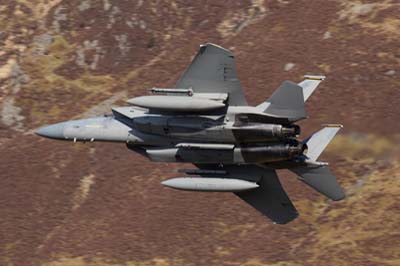 |
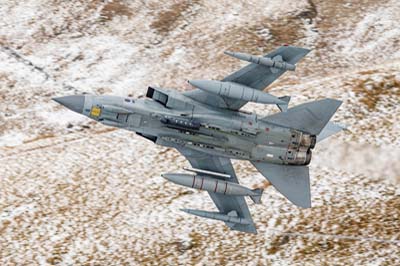 |
| Left to right: Tornado GR.4 (ZA453 '022') with a AN/AAQ-28 Litening III Targeting pod. DSLR full-frame sensor + Canon EF 400mm f2.8 L IS Mk.II at 1/1000 f5.6 ISO 200 with -1/3 exposure compensation. Tornado GR.4 (ZD895 '115') of 9 Squadron. DSLR full-frame sensor + Canon EF 400mm f2.8 L IS Mk.II at 1/1000 f6.3 ISO 200 with -2/3 exposure compensation. F-15C Eagle (86-0175 'LN') of 493rd Fighter Squadron, 48th Fighter Wing in mid Wales in April 2013. DSLR full-frame sensor + Canon EF 400mm f2.8 L IS Mk.II at 1/1000 f7.1 ISO 200 with -1/3 exposure compensation. Tornado GR.4 (ZA588 '056') callsign 'Primus 01' in February 2018. DSLR full-frame sensor + Canon EF 400mm f2.8 L IS Mk.II at 1/1250 f4.5 ISO 250 with -1/3 exposure compensation. |
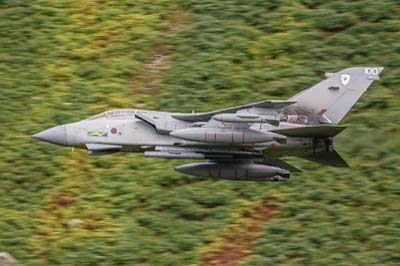 |
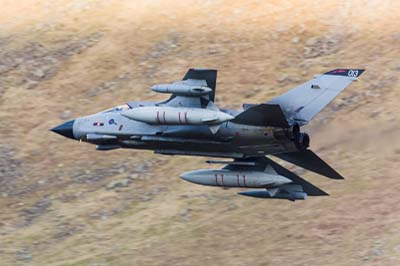 |
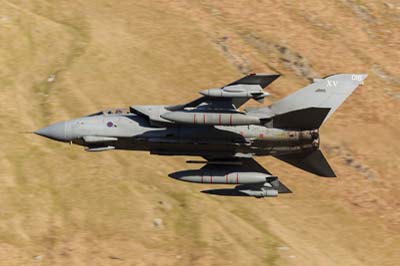 |
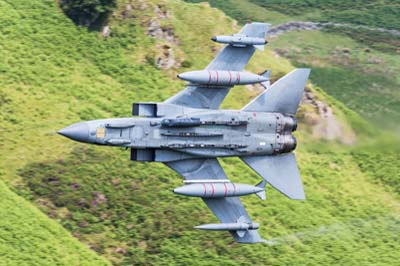 |
| Left to right: Tornado GR.4 (ZD792 '100') of 13 Squadron with a Thermal Imaging Airborne Laser Designator (TIALD) pod fitted under the fuselage, in August 2009. DSLR x1.6 sensor + Canon EF 300mm f2.8L 1/640 at f.4 ISO 200 with -1/3 exposure compensation. Tornado GR.4A (ZA404 '013') fitted with a pair of 2,250 litre 'Hindenburger' fuel tanks during Exercise Fast Mover on February 28, 2013. DSLR full-frame sensor + Canon EF 400mm f2.8 L IS Mk.II at 1/1000 at f3.5 with -2/3 stop exposure compensation and ISO 200. Tornado GR.4 (ZA410 '016') of XV Squadron in the Lakes in February 2013. DSLR full-frame sensor + Canon EF 400mm f2.8 L IS Mk.II at 1/1000 at f.7.1 with -2/3 stop exposure compensation and ISO 200. Tornado GR.4 (ZG791 '137') it is fitted with an AN/AAQ-28 Litening III Targeting pod in July 2015. DSLR full-frame sensor + Canon EF 400mm f2.8 L IS Mk.II at 1/1000 at f7.1 with -1 stop exposure compensation and ISO 200. |
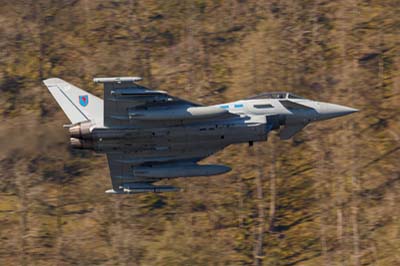 |
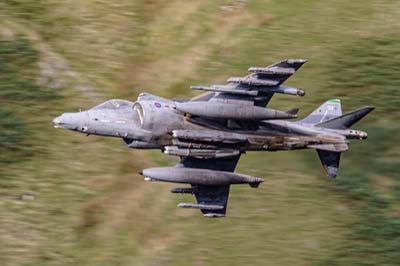 |
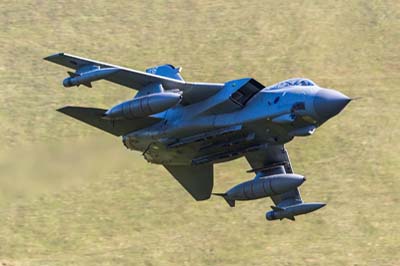 |
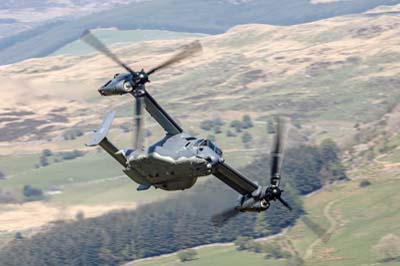 |
| Left to right: Typhoon FGR.4 (ZK326 'EP') of 6 Squadron in March 2012. DSLR full-frame sensor + Canon EF 400mm f2.8 L IS Mk.II 1/1000 at f.5.6 ISO 200 -1 stop exposure compensation. Harrier GR.7 (ZD379 '27') then of 3(F) Squadron taken in September 2005. The Harrier is fitted with two dummy 25mm cannon pods, as a useable cannon had yet to be delivered by Royal Ordnance. The dummy weaponry is carried to produce a 'ground cushion effect' required for Short Take-Off and Vertical Landing (STOVL). Life Improvement Devices (LIDs) with or without a TIALD thermal imaging laser pods are also be carried for the same reason. Low-flying late in the afternoon the sun just caught the Harrier for this single frame. Tornado GR.4 (ZA543 '036') in July 2014. DSLR full-frame sensor + Canon EF 400mm f2.8 L IS Mk.II at 1/1000 f5 ISO 200 with -1/3 exposure compensation. Bell CV-22B Osprey (11-0058) from the 7th Special Operations Squadron based at RAF Mildenhall in May 2017. |
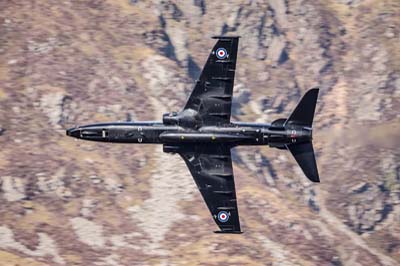 |
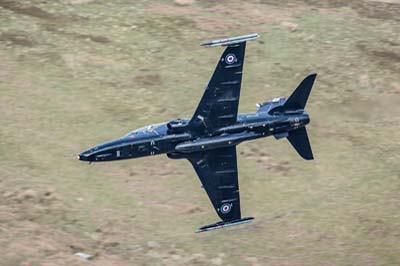 |
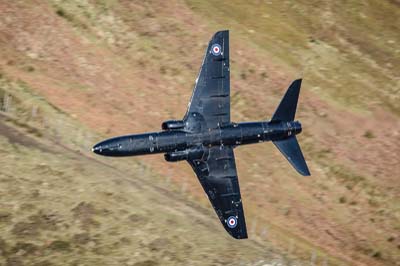 |
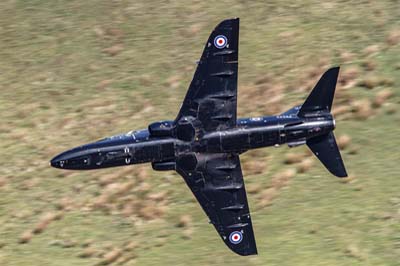 |
| Left to right: Hawk T.2 (ZK019 'J') of 4(R) Squadron in March 2016. DSLR full-frame sensor + Canon EF 400mm f2.8 L IS Mk.II at 1/1000 f5.6 ISO 200 with -2/3 exposure compensation. Hawk T.2 (ZK035 'Z') of 4(R) Squadron in April 2016. DSLR full-frame sensor + Canon EF 400mm f2.8 L IS Mk.II at 1/1250 f4 ISO 200. Hawk T.1 (XX287) of 208(R) Squadron in March 2016. DSLR full-frame sensor + Canon EF 400mm f2.8 L IS Mk.II at 1/1000 f7.1 ISO 200 with -2/3 exposure compensation. Hawk T.1 (XX244) of 208(R) Squadron in May 2010. |
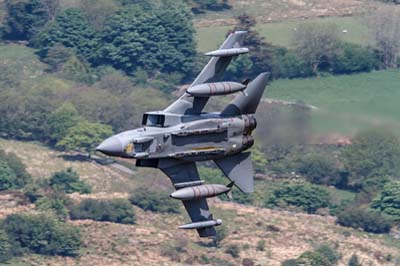 |
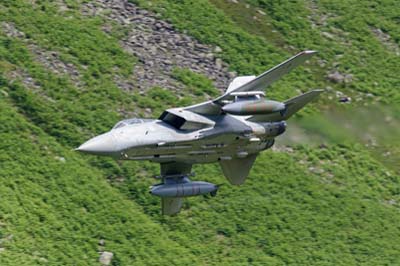 |
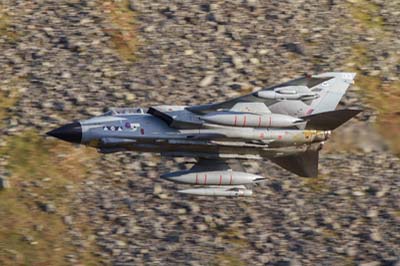 |
| Left to right: Tornado GR.4 (ZA562 '051') devoid of squadron markings in May 2010. DSLR x1.6 sensor + Canon EF 300mm f2.8L with x1.4 extender 1/1000 at f8 ISO 200 -1 stop exposure compensation. Tornado F.3 (ZE254 'UD') of 25(F) Squadron from RAF Leeming in June 2005. Tornado GR.4A (ZA404 '013') of 2 Squadron in January 2012. DSLR x1.6 sensor + Canon EF 300mm f2.8L 1/640 at f5 ISO 200 -1 stop exposure compensation. |
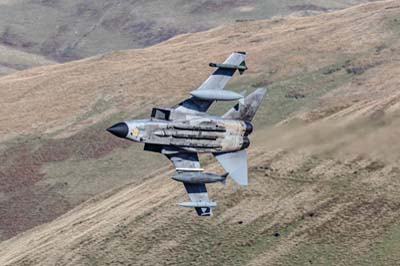 |
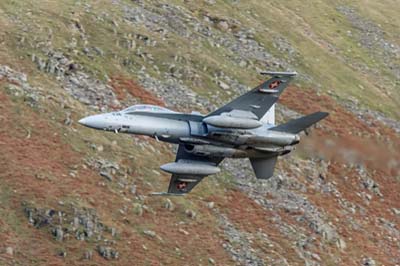 |
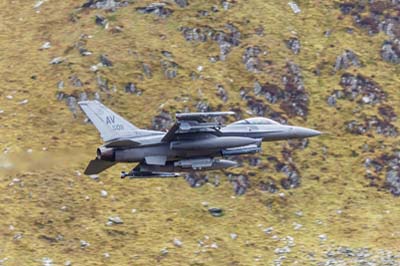 |
| Left to right: Tornado ECR (46+24) of German Air Force JBG 32 in the Selkirk to Moffat valley in October 2012. DSLR full-frame sensor + Canon EF 400mm f2.8 L IS Mk.II plus a x1.4 extender at 1/1000 f5.6 ISO 100 with -2/3 exposure compensation. McDonnell Douglas F/A-18D Hornet (J-5236) Swiss Air Force in December 2021. DSLR full-frame sensor + Canon EF 400mm f2.8 L IS Mk.II at 1/1600 f2.8 ISO 1000 with -1/3 exposure compensation. General Dynamics F-16CM-40E Fighting Falcon (89-2011 'AV') using callsign 'SCOFF 11' with 510 FS, 31 FW based at Aviano and deployed to RAF Lakenheath in March 2022. On each wing tip pylon: CATM-120 (Captive Air Training Missile) which is an inert store to simulate a AIM-120 AMRAAM (Advanced Medium-Range Air-to-Air Missile) Air Intercept Missile for training purposes. Starboard side outer pylon: CATM-9M to simulate a AIM-9M Sidewinder. Starboard chin station: AN/AAQ-33 Sniper Advanced Targeting Pod. Centreline: AN/ALQ-131 Electronic Countermeasures (ECM) pod. Inner wing pylons: Two 370 gallon external drop fuel tanks. Port side outer pylon: P5 Combat Training System (CTS/TCTS) and Air Combat Manoeuvring Instrumentation (ACMI) pod to record the aircraft's in-flight data. Mirrorless DSLR full-frame sensor + Canon EF 400mm f2.8 L IS at 1/2000 f2.8 ISO 500 with -1/3 exposure compensation. |
| Side on shots showing squadron markings for use as an historical record. |
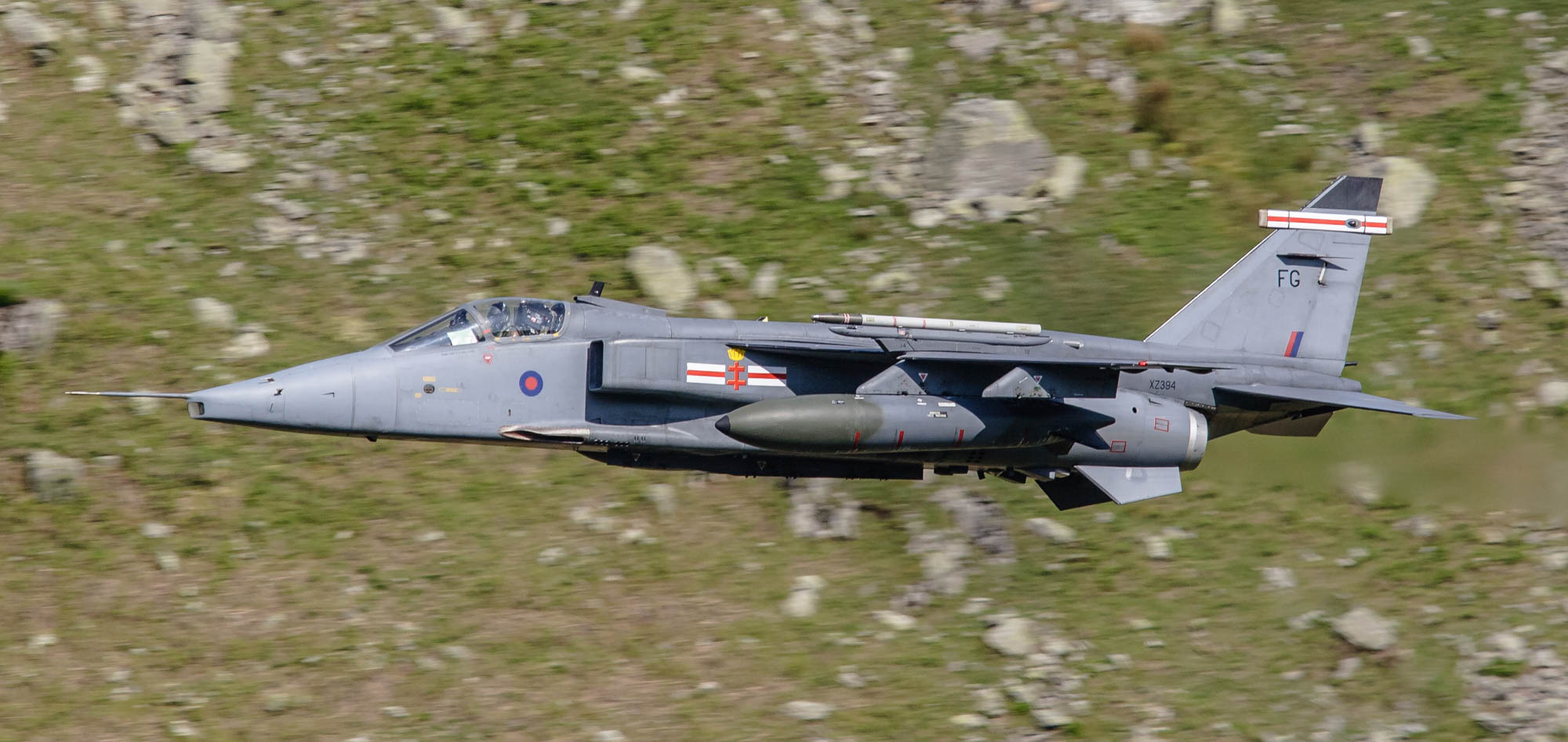 |
| Jaguar GR.3 (XZ394 'FG') with 41 Squadron when based at RAF Coltishall in June 2005. |
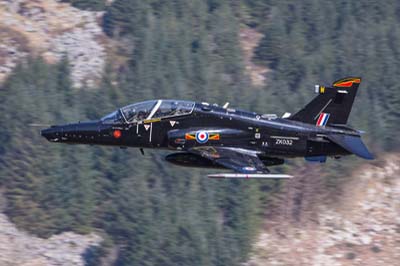 |
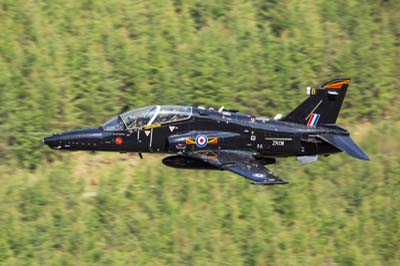 |
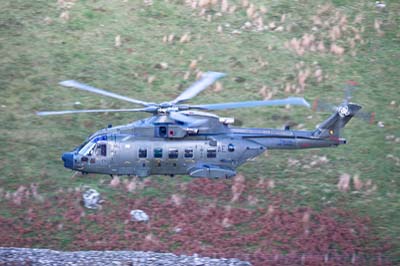 |
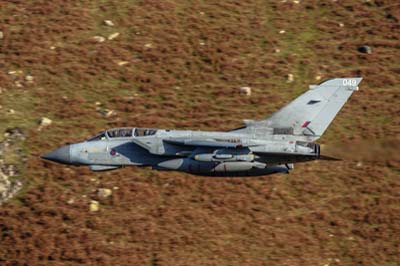 |
| Left to right: Hawk T.2 (ZK032 'W') with 4(R) Squadron in April 2014. DSLR full-frame sensor + Canon EF 400mm f2.8 L IS Mk.II at 1/1250 f6.3 ISO 200 with -1 exposure compensation. Hawk T.2 (ZK011 'B') with 4(R) Squadron in April 2014. DSLR full-frame sensor + Canon EF 400mm f2.8 L IS Mk.II at 1/1250 f5.6 ISO 200 with -1 exposure compensation. Westland Merlin HC.3A (ZJ998 'AE') still of 28 Squadron through the Loop in December 2014. DSLR full-frame sensor + Canon EF 400mm f2.8 L IS Mk.II at 1/250 at f.4 with -1/3 stop exposure compensation and ISO 160. Tornado GR.4 (ZA559 '049') using callsign 'Fang 22' in the Lakes in October 2016. DSLR full-frame sensor + Canon EF 400mm f2.8 L IS Mk.II at 1/1250 at f.5 with -2/3 stop exposure compensation and ISO 200. |
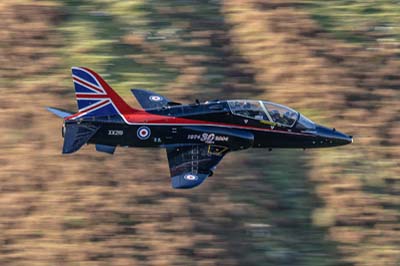 |
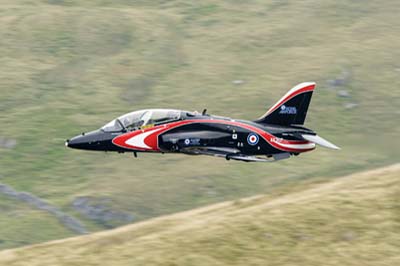 |
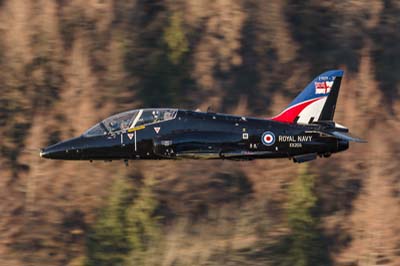 |
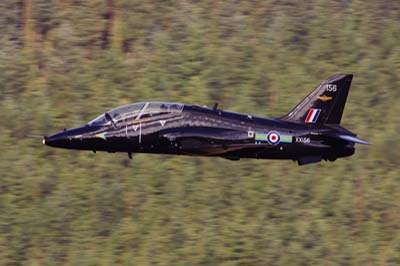 |
| Left to right: One of two Hawk T.1s (XX219) specially painted for the 2004 display season, it was inscribed '1974-2004 30 years'. As there is an increased risk of a bird strike when flying at low-level, it was decided not to fly specially painted Hawks at low-level until the display season has finished. It was photographed flying low through the Lake District in December 2004. Hawk T.1 (XX307) in the new paint scheme for the 2007 display season. August 2007. Hawk T.1 (XX205) Royal Navy in February 2013. DSLR full-frame sensor + Canon EF 400mm f2.8 L IS Mk.II + x1.4 Mk.III extender at 1/800 at f.4 with -2/3 stop exposure compensation and ISO 200. Just keep clicking on image to see how sharp it is! Hawk T.1 (XX156) of 208(R) Squadron in October 2008. DSLR x1.6 sensor + Canon EF 300mm f2.8L 1/640 at f.5 ISO 200 with -2/3 exposure compensation. |
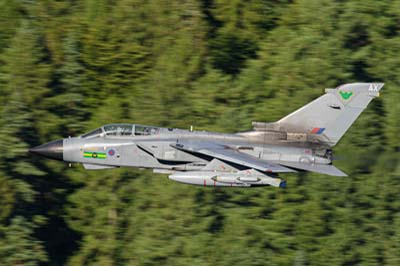 |
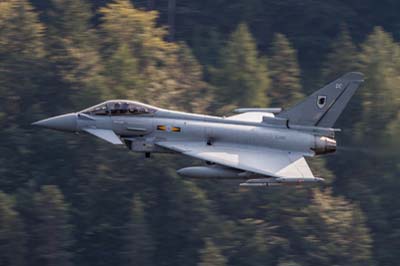 |
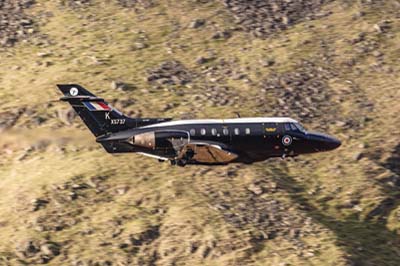 |
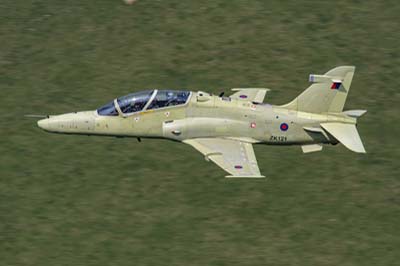 |
| Left to right: Tornado GR.4 (ZA551 'AX') in full 9 Squadron markings before Tornado fleet numbering had taken hold in June 2006. Typhoon FGR.4 (ZJ919 'DC') of 11(F) Squadron in September 2010. DSLR x1.6 sensor + Canon EF 300mm f2.8L 1/640 at f.5 ISO 200 with -2/3 exposure compensation. Dominie T.1 (XS737 'K') of 55(R) Squadron which is part of 3 FTS based at Cranwell which approached quite high, as Dominie's operate lower speeds (210 knots or two miles a minute), I was able to scramble up the hill a little and was able to catch it as it passed in front of the high peak in front, December 2005. DSLR x1.6 sensor + Canon EF 300mm f2.8L 1/500 at f.5.6 ISO 200 with -2/3 exposure compensation. Hawk 132 (ZK121) is with BAE Systems at Warton being tested prior to delivery to the Indian Air Force in May 2008. DSLR x1.6 sensor + Canon EF 300mm f2.8L 1/800 at f.9 ISO 200 with -2/3 exposure compensation and x1.4 extender. |
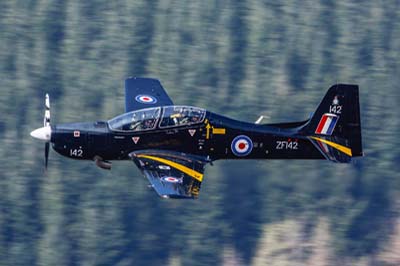 |
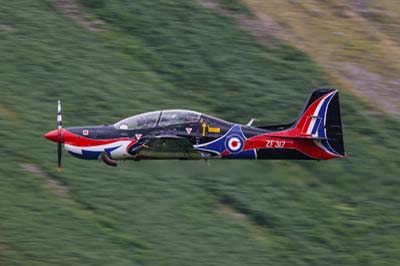 |
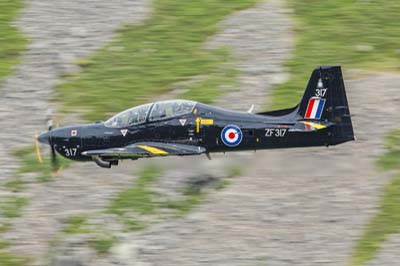 |
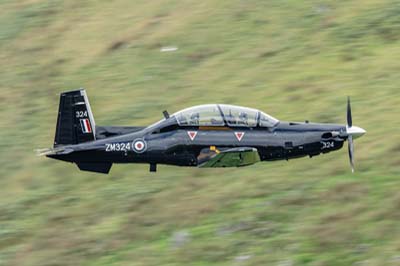 |
| Left to right: Tucano T.1 (ZF142) using callsign 'Linton 17' at low-level in Wales before going on to RAF Shawbury in March 2009. DSLR x1.6 sensor + Canon EF 300mm f2.8L 1/320 at f.5 ISO 100 with -2/3 exposure compensation. Tucano T.1 (ZF319) in stunning 2009 display 'shark' markings in August 2009 through the Lake District. DSLR x1.6 sensor + Canon EF 300mm f2.8L 1/320 at f.7.1 ISO 200 with -2/3 exposure compensation. Tucano T.1 (ZF317 '317') using callsign 'Uzi 12' of 72(Reserve) Squadron through the Kirkstone Pass in July 2019. DSLR full-frame sensor + Canon EF 400mm f2.8 L IS Mk.II at 1/250 f.9 ISO 200 with -2/3 exposure compensation. Texan T.1 (ZM324) with 72 Squadron based at RAF Valley in July 2020. |
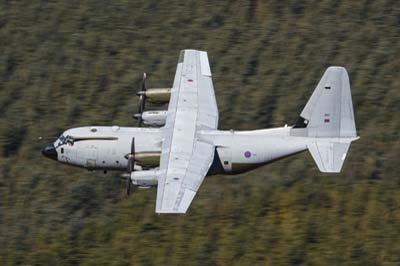 |
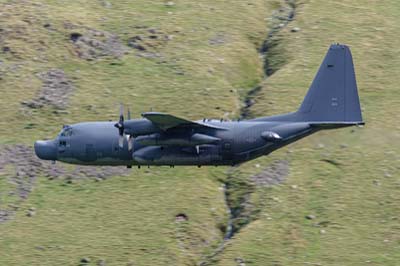 |
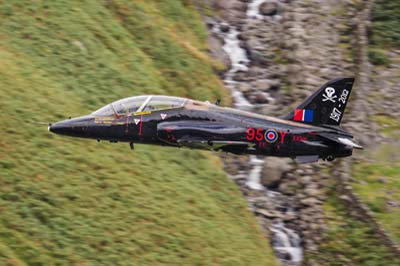 |
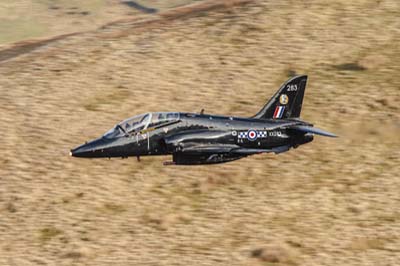 |
| Left to right: C-130J Hercules C.5 (ZH884) of 30 Squadron in March 2010. DSLR x1.6 sensor + Canon EF 70mm-200mm (140mm) f2.8L at 1/160 at f.11 with -1 stop exposure compensation and ISO 100. The seldom seen MC-130H Combat Talon II (88-0191 callsign 'Talon 71') of 7 SOS, 352 SOG based at Mildenhall in August 2009. DSLR x1.6 sensor + Canon EF 70-200mm (200mm) f2.8L 1/320 at f.8 ISO 160 with -2/3 exposure compensation. Hawk T.1 (XX318 '95Y') inscribed '1912-1917' for the 95th anniversary of 100 Squadron in September 2013. DSLR full-frame sensor + Canon EF 400mm f2.8 L IS Mk.II at 1/1000 f3.2 ISO 250 with -1/3 exposure compensation. Hawk T.1W (XX283) of 19(R) Squadron in December 2009. It is fitted with a 30mm Aden Mk4 Cannon pack. The gun can carry 120 rounds of ammunition and has a rate of fire of 1200 rounds per minute. It is used by 19(R) Squadron for strafing practice on the range at RAF Pembrey Sands on the South Wales coast or for Air to Air firing at a banner towed by another Hawk. DSLR x1.6 sensor + Canon EF 300mm f2.8L 1/640 at f.5 ISO 200 with -2/3 exposure compensation. |
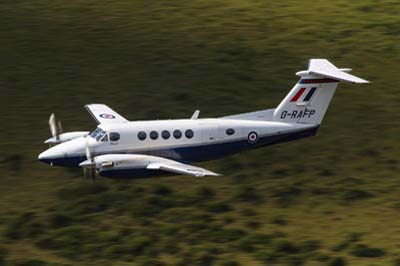 |
 |
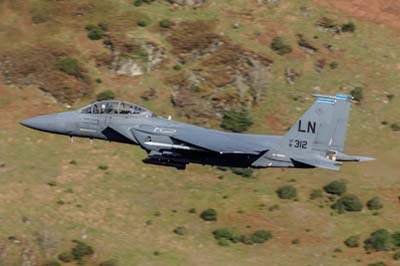 |
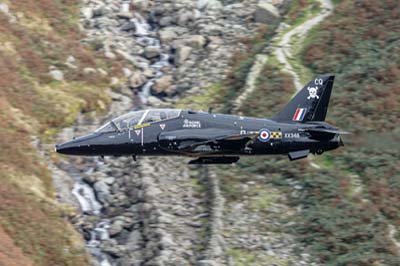 |
| Left to right:
Super King Air B200 (G-RAFP) of 45(R) Squadron in June 2010. DSLR x1.6 sensor + Canon EF 300mm f2.8L 1/250 at f.10 ISO 200 with -1.1/3 exposure compensation ISO 100. Super King Air B200 (ZK459 'X') of 45(R) Squadron based at RAF Cranwell in June 2017. DSLR full-frame sensor + Canon EF 400mm f2.8 L IS Mk.II at 1/250 f10 ISO 200 with -2/3 exposure compensation. F-15E Strike Eagle (91-312 'LN') callsign 'Rage 11' in colours (blue fin tip) of 492 FS, 48 FW in November 2017. DSLR full-frame sensor + Canon EF 400mm f2.8 L IS Mk.II at 1/1250 f4.5 ISO 320 with -2/3 exposure compensation. Hawk T.1 (XX348 'CQ') with 100 Squadron in the Lake District in September 2020. |
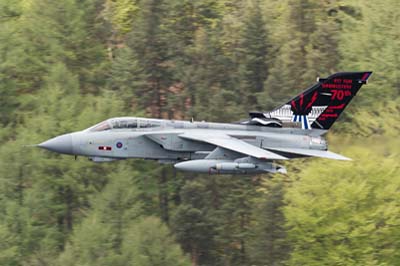 |
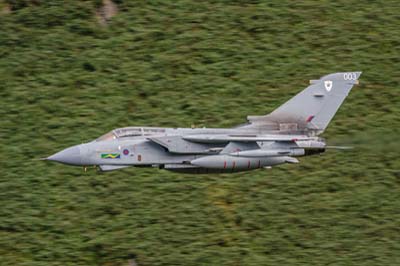 |
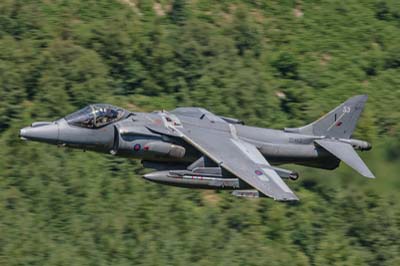 |
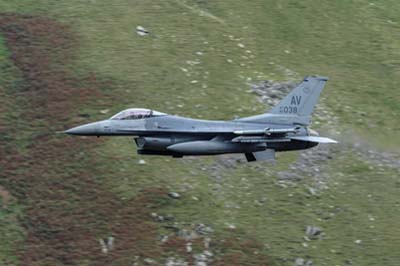 |
| Left to right: Tornado GR.4 (ZA492) using callsign 'Gibson 1' for the 70th Anniversary flypast in the Derwent Valley on May 16, 2013. DSLR full-frame sensor + Canon EF 400mm f2.8 L IS Mk.II at 1/1000 f5.0 ISO 320 with -1/3 exposure compensation. Tornado GR.4A (ZA369 '003') first of a pair from of 13 Squadron in August 2009. DSLR x1.6 sensor + Canon EF 300mm f2.8L 1/640 at f.4.5 ISO 200 with -1/3 exposure compensation. Unmarked Harrier GR.9 (ZD463 '53') in June 2009. DSLR x1.6 sensor + Canon EF 300mm f2.8L 1/800 at f.7.1 ISO 200 with -1 stop exposure compensation. F-16C Fighting Falcon (89-2038 'AV') with 510 Fighter Squadron, 31 Fighter Wing based in Aviano, Italy, deployed to RAF Lakenheath in September 2020. |
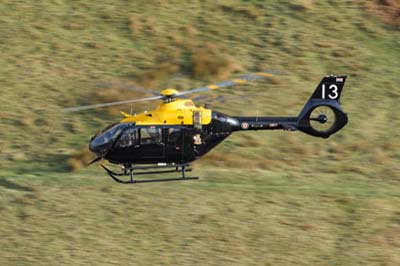 |
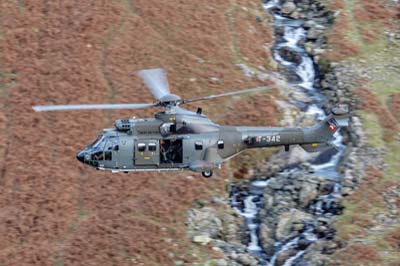 |
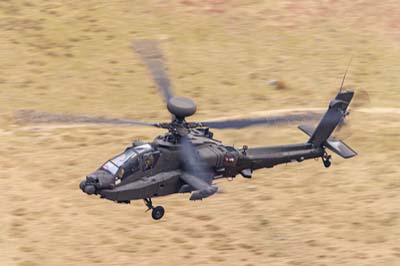 |
| Left to right: Airbus Helicopters H135 Juno HT.1 (ZM513 '13') using callsign 'Shawbury 87' it is with No.1 Flying Training School (1 FTS) at RAF Shawbury in December 2021. DSLR full-frame sensor + Canon EF 400mm f2.8 L IS Mk.II at 1/160 f7.1 ISO 160 with -2/3 exposure compensation. AS.532UL (TH98) Cougar (T-332) with Swiss Air Force Lufttransport Geschwader 2 (Air Transport Wing 2) based at Alpnach in December 2021 in LFA17. DSLR full-frame sensor + Canon EF 400mm f2.8 L IS Mk.II at 1/160 f3.2 ISO 320. AH-64E Apache Guardian (ZM706) using callsign 'Ugly 02' it is with 662 Squadron, 3 Regiment Army Air Corps (AAC), 1st Aviation Brigade Combat Team based at Wattisham Flying Station. Operating around Spadeadam and the Lakes in March 2022. DSLR full-frame sensor + Canon EF 400mm f2.8 L IS Mk.II plus x1.4 Extender at 1/160 f6.3 ISO 100. |
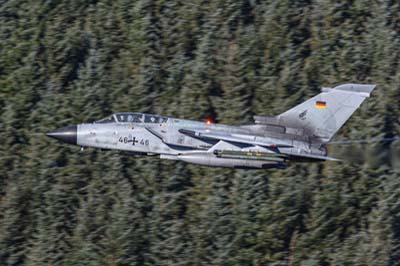 |
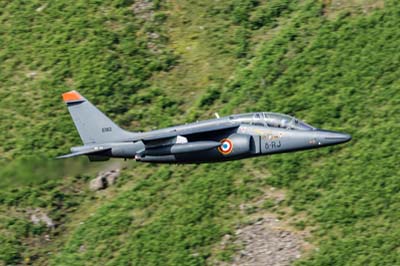 |
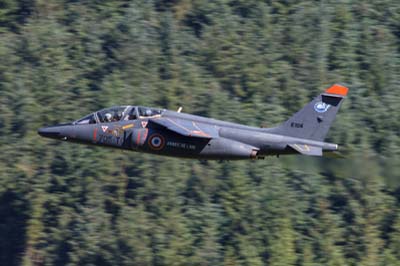 |
| Left to right: Tornado ECR (46+46) of German Air Force JBG 32 in the Selkirk to Moffat valley in October 2012. DSLR full-frame sensor + Canon EF 400mm f2.8 L IS Mk.II plus a x1.4 extender at 1/1000 f5.0 ISO 100 with -2/3 exposure compensation. Alpha Jet E (E162 '8-RJ') using callsign 'Marcou 11' with Escadron d'Entrainement 03.008 (EE 03.008) Côte d'Or Armée de l'Air n the Lakes in July 2019. DSLR full-frame sensor + Canon EF 400mm f2.8 L IS Mk.II at 1/1600 f.4 ISO 200 with -2/3 exposure compensation. Alpha Jet E (E104 '705-TG') from the French Air Force's (Armée de l'Air) Ecole de L' Aviation de Chasse 00.314 based at Tours during an exchange with 208(R) Squadron in June 2010. DSLR x1.6 sensor + Canon EF 300mm f2.8L 1/800 at f.5 ISO 160 with -1 stop exposure compensation. |
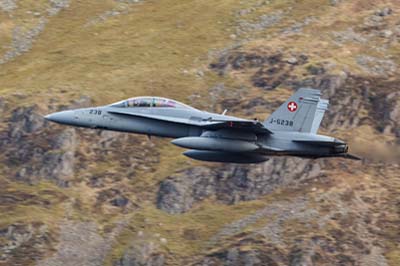 |
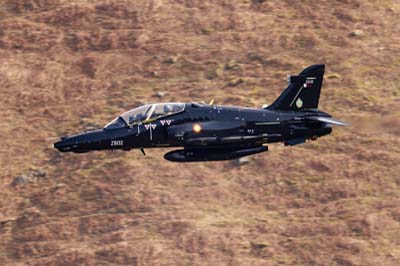 |
| Left to right: Swiss Air Force F/A-18D Hornet (J-5238) using callsign 'Crusader 21' through the Lakes in November 2019. DSLR full-frame sensor + Canon EF 400mm f2.8 L IS Mk.II at 1/1250 f3.5 ISO 800 with -2/3 exposure compensation. Hawk Mk167 (ZB132 QA002) with 11 Squadron (Qatar), Qatari Emiri Air Force (QEAF) based at RAF Leeming. DSLR full-frame sensor + Canon EF 400mm f2.8 L IS Mk.II plus x1.4 extender at 1/2000 f4 ISO 250 with -1/3 exposure compensation. |
|
|